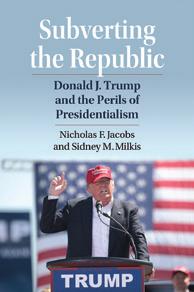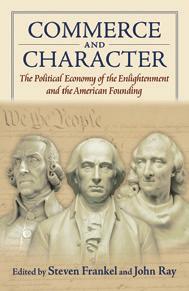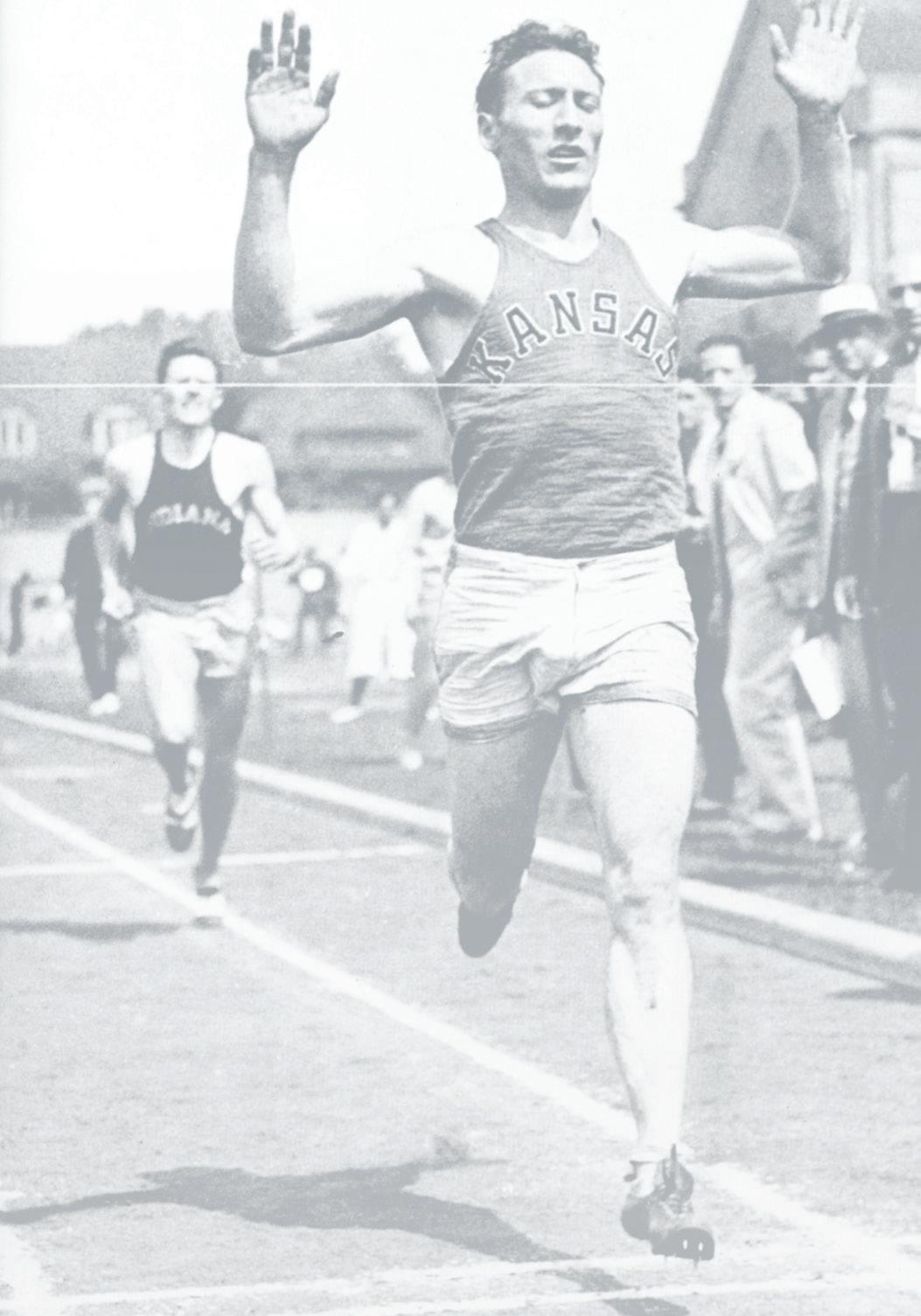

KANSAS UNIVERSITY PRESS OF
New Books for Spring & Summer 2025

Bronze Medal, Education (Commentary/Theory), Independent Publisher Book Awards

Benjamin F. Shambaugh Award, State Historical Society of Iowa

Army Historical Foundation Distinguished Writing Award in Institutional/Functional History


Honorable Mention, American Academy of Religion Best First Book in the History of Religions

Susanne M. Glasscock Book Prize, Melbern G. Glasscock Center for Humanities Research, Texas A&M University

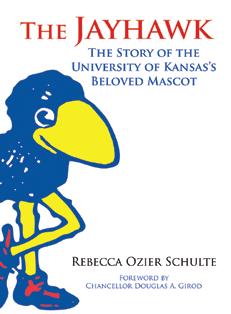
Finalist,
The Year Low Culture Conquered America and Kickstarted Our
Bizarre Times
Ross Benes
The year 1999 was a high-water mark for popular culture. According to one measure, it was the “best movie year ever.” But as journalist Ross Benes shows, the end of the ’90s was also a banner year for low culture. This was the heyday of Jerry Springer, Jenna Jameson, and Vince McMahon, among many others. Low culture had come into its own and was poised for world domination. The reverberations of this takeover continue to shape American society.
During its New Year’s Eve countdown, MTV entered 1999 with Limp Bizkit covering Prince’s famous anthem to the new year. The highlights of the lowlights continued when WCW and WWE drew 35 million US viewers each week with sex appeal and stories about insurrections. Insane Clown Posse emerged from the underground with a Woodstock set and platinum records about magic and murder. Later that year, Dance Dance Revolution debuted in North America and Grand Theft Auto emerged as a major video game franchise. Beanie Babies and Pokémon so thoroughly seized the wallets and imagination of collectors that they created speculative investment bubbles. The trashy talk show Jerry Springer became daytime TV’s most-watched program. Among Springer’s many guests were porn stars who, at the end of the millennium, were pursuing sex records in a bid for stardom as the pornography industry exploded. Donald Trump even explored a potential presidential nomination with the Reform Party in 1999 and wanted his running mate to be Oprah Winfrey, whose own talk show would make Dr. Oz a household name.
Benes shows us how so many of the strangest features of culture in 1999 predicted and influenced American life today. This wild ride through pop culture uncovers the connections between the kayfabe of WWE and the theatrics of politics, between the faddish obsession with Beanie Babies and with NFTs, between faithful fans and political loyalists, between violent video games and society’s scapegoats, and much more. 1999 is not just a nostalgic look at the past. It is also a window into our contentious present.
Ross Benes is an award-winning journalist and author, whose writing has appeared in Rolling Stone, Vice, Nation, The Wall Street Journal, and beyond. He has also written three books, including Rural Rebellion: How Nebraska Became a Republican Stronghold and Turned On: A MindBlowing Investigation into How Sex Has Shaped Our World
Politics and Pop Culture
APRIL
296 pages, 6 x 9
Cloth ISBN 978-0-7006-3857-4, $32.99 (t)
Ebook ISBN 978-0-7006-3858-1, $14.99

“Ross Benes is one of the boldest and bawdiest writers I’ve ever worked with; I always worried that even editing him might get me arrested. His shrewd excavations of lowbrow culture reads like high art, whether he’s taking on Pokémon or porn. I’d tell you he never breaks kayfabe, but it’s simpler than that: he’s the real thing.”
Rob Harvilla, author of 60 Songs That Explain the ’90s
“I’ve been trying to figure out when, exactly, the world started falling apart, and I had started to worry the answer was, ‘always.’ That may yet be true, but I find it more comforting to go with Ross Benes’s compellingly, entertainingly argued case that it all fell apart in the age of Limp Bizkit and Juggalos . . . which is to say, in 1999, when the world started looking a lot like it does now. This book is smart, funny, and persuasive . . . though not as comforting as I might wish it were.”
Will Leitch, author of How Lucky and The Time Has Come
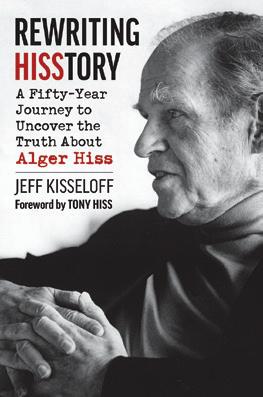
“I defy anyone with an open mind to read this book and dispute its conclusion that a grave injustice was done to a devoted public servant. This is, truthfully, the most important book ever written on the Hiss case. Kudos to Jeff Kisseloff for the research Hiss’s detractors never did, but we now have.”
Peter Irons, author of Cold War Crusaders: Harry Truman and the Architects of McCarthyism
“Civic injustices that remain unaddressed do not vanish, but fester, poisoning the body politic and leading to an underlying cynicism. Jeff Kisseloff, working to undo one such injustice, has devoted much of his life to investigating the circumstances surrounding the 1950 conviction of Alger Hiss for perjury. In this riveting account of impeccable journalistic research, Kisseloff leads us step-bystep to the perpetrators of the deception that destroyed the career of one of America’s finest civil servants and fed a culture of fear and division that harmed countless others.”
Julia M. Allen, author of Passionate Commitments: The Lives of Anna Rochester and Grace Hutchins
Rewriting Hisstory
A Fifty-Year Journey to Uncover the Truth About Alger Hiss
Jeff Kisseloff
Foreword by Tony Hiss
When Alger Hiss was accused by Whittaker Chambers in 1948 of being a secret Communist spy in the 1930s, the subsequent perjury trials were some of the most sensational and politically significant trials of the century. Although Hiss was convicted, he maintained his innocence until his death, and historians have taken sides ever since. In this groundbreaking and revelatory book, Jeff Kisseloff brings new perspective, evidence, and accusations to this historical controversy.
Rewriting Hisstory is a firsthand account of how over fifty years, beginning when he worked for Hiss as a college student in the mid-1970s, Kisseloff was eventually able to determine the truth about Alger Hiss. With the skills of a veteran reporter and the analytical mind of a scholar, he brings to light a wealth of original material, including 150,000 pages of mostly unredacted previously unreleased FBI files—which he sued the FBI to obtain—and other documents from government and library collections around the country. Kisseloff also acquired a key piece of evidence: Woodstock 230099, the machine that the government claimed was used to type the copies of State Department documents placed in evidence against Hiss.
Taken together, Kisseloff has pieced together the truth, showing that Hiss was neither a Communist nor a spy and that the government knew it. But if Hiss didn’t produce the documents that were placed in evidence against him, who did? After careful research and by applying a process of elimination used in classic crime novels—who had the means, motive, and opportunity to do the job—Kisseloff points his finger at the only people who fit all three qualifications.
An act of vindication for one of the most divisive figures in the twentieth century, Rewriting Hisstory is a thrilling political page-turner about an accused spy that is itself a work of scholarly espionage, built on decades of painstaking research. This is an iconoclastic work that should rewrite history books.
Jeff Kisseloff is a former newspaper reporter and editor whose writing has appeared in the New York Times, The Nation, and elsewhere. He is also the author of five books, including Generation on Fire: Voices of Protest from the 1960s—An Oral History, The Box: An Oral History of Television, 1920 to 1961, and You Must Remember This: An Oral History of Manhattan from the 1890s to World War II.
APRIL
384 pages, 26 photographs, 6 x 9 Hardcover ISBN 978-0-7006-3833-8, $34.99 (t) Ebook ISBN 978-0-7006-3834-5, $14.99
The Guide to Kansas Birds and Birding Hotspots
Second Edition, Revised and Expanded
Pete Janzen and Bob Gress
Foreword by Kenn Kaufman
Kansas is a bird-watcher’s paradise, boasting exceptional habitat diversity and a key location at the hub of the hemisphere’s migration corridors. An astounding 486 avian species have been documented in the state. In this greatly expanded edition of their award-winning guide, renowned experts Pete Janzen and Bob Gress have gathered a wealth of information on 321 species and 100 birding hotspots in Kansas.
Janzen and Gress offer beautiful photographs, useful identification information, and field notes on habitat, seasonal occurrence, and more. The guides to birding hotspots throughout the state highlight the unique species and seasonal features of the most diverse and exciting places Kansas has to offer and will help you plan your next adventure. Additionally, Janzen and Gress have included essays on topics like birding basics and the geography and ecosystems of Kansas, along with a calendar of bird activity in Kansas and a complete species checklist of Kansas birds. This new edition is a must-have guide for every backyard enthusiast and day-tripping birder.
Pete Janzen is active in the Kansas Ornithological Society and the Wichita Audubon Society and is the author of The Birds of Sedgwick County and Cheney Reservoir, as well as numerous articles and papers devoted to birding in Kansas and Oklahoma.
Bob Gress is a former director of the Great Plains Nature Center in Wichita, coauthor of Birds of Kansas and Faces of the Great Plains, a widely published photographer, and the cofounder of the website Birds in Focus
Kenn Kaufman is the author of the popular Kaufman Focus Guides to birds, butterflies, insects, and mammals of North America and the recipient of the American Birding Association’s prestigious Ludlow Griscom Award.
JULY
528 pages, 576 color photographs, 7 maps, 2 figures, 6 x 9
Paperback ISBN 978-0-7006-3859-8, $34.99 (t)
Ebook ISBN 978-0-7006-3860-4, $14.99

“Fortune has favored the Kansas bird enthusiast with this tour de force guide to the state’s birds and birding locations. Expertly prepared and magnificently useful, it is a resource that birders in other states should hope and strive to emulate.”
Dan L. Reinking, current senior biologist at the George Miksh Sutton Avian Research Center and author of Oklahoma Winter Bird Atlas
“As the authors point out, this book is a ‘less intimidating introduction to the birds of Kansas.’ It is an accurate description that predicts its applicability to that great middle ground of birders and birdwatchers, the serious beginners and relaxed veterans. Despite its quite comprehensive nature, this book is nevertheless an easy-to-use reference written in a relaxed style that I strongly recommend to anyone interested in Kansas birds.”
Ross Silcock, coauthor of Birds of Nebraska: Their Distribution and Temporal Occurrence
“Janzen and Gress are especially to be commended for their thorough coverage of the many recent changes to the dynamic, adaptable, and rapidly changing birdlife of the state.”
Ted Floyd, editor of Birding magazine
The Guide to Kansas Birds and Birding Hotspots
Second Edition, Revised and Expanded
Pete Janzen and Bob Gress
Foreword by Kenn Kaufman
Field Identification: Adults are similar in size and shape to Snowy Egrets but are a slate-blue color on most of the body, with a dark reddish-purple head and neck. Adults have a blue bill with a black tip. Juveniles are completely white and are most easily distinguished from the other white herons by their pale pinkish bill with a black tip. At about one year of age, the white plumage starts giving way to the dark adult plumage. This transitional plumage is sometimes referred to as “calico.” Size: Length 24 inches; wingspan 40 inches.
Habitat and Distribution: Wetlands, streams, and lakeshores, mostly in the eastern two-thirds of Kansas. Has been recorded in 84 counties.

Seasonal Occurrence: Summer resident. Present from April through October. Confirmed breeding has been documented in 10 south-central and eastern counties.
Field Notes: This heron nests in large colonies that often include other heron species, including Great Egrets, Snowy Egrets, Western Cattle Egrets, and Blackcrowned Night
Herons. In late summer, postbreeding birds wander widely and can be found across the state. It sometimes feeds along wooded streams and shores, where other egrets are not typically found.


Field Identification: This is the largest of the white herons. The colors of the bill and legs are the most helpful field marks to easily differentiate the white heron species. Great Egrets have a large yellow bill, and the long legs are completely black. In spring and early summer, they have showy plume feathers, called aigrettes, on the breast and wings. Size: Length 39 inches; wingspan 51 inches.
Habitat and Distribution:
Seen at lakes, ponds, streams, flooded fields, and wetlands. Mostly found in central and eastern Kansas but has been seen west to the Colorado border. Has been recorded in 100 Kansas counties.
Seasonal Occurrence: Summer resident. Arrives in late March, and most individuals depart in October. A few linger into November and early December. In late summer, postbreeding wanderers can turn up anywhere in the state. There are confirmed breeding records from seven south-central and eastern counties.

and frogs, and readily hunt at almost any location with water.
Field Notes: Egrets are herons that are white. Great Egrets are more numerous and widespread in Kansas today than they were 40 years ago. They typically nest in large mixed-species heron rookeries. Postbreeding wanderers sometimes gather in large numbers when abundant prey is present, especially at Cheyenne Bottoms, Glen Elder WA, and Quivira NWR. Like the Great Blue Heron, they

321 Kansas bird species featured with full-color photographs

Field Identification: This large woodpecker has a brown back with narrow black bars, a white breast with round spots, and a black bib marking on the chest. The wing linings are yellow or red depending on the subspecies. Males of the Red-shafted subspecies have a gray face and red mustache mark, while those of the Yellowshafted subspecies have a brown face and black mustache mark. Females lack mustache marks. Size: Length 12 inches; wingspan 20 inches.
Habitat and Distribution: Statewide in brushy open country, woodlands, and urban areas. There are records from all 105 counties.


Seasonal Occurrence: Present yearround, although populations fluctuate by season. In spring and fall, large flocks of migrating flickers are often observed, especially in March and October. Many remain statewide in winter. Widespread in summer but not as numerous as in winter. There are confirmed nesting records from 81 counties.
Field Notes: Northern Flickers are named for their peculiar calls, which are often interpreted as flicker flicker flicker flic Most flickers seen in the summer in Kansas are of the Yellow-shafted subspecies. In winter, Red-shafted birds move onto the plains from the mountains. The two subspecies hybridize on the Great Plains, and intermediate birds are often observed. Flickers are fond of eating ants and other insects while perched on the ground.

WADING BIRDS
WADING BIRDS
Ardea alba
Great Egret
Little Blue Heron
Egretta caerulea
Merganser, Pied-billed Grebe, and American Coot lurking in the cover. Located a half mile south of Jetmore on US 283 is the Jetmore Cemetery. The cemetery has many mature juniper trees and is a reliable location for Townsend’s Solitaire in winter. Some observers have reported up to 20 of them here in a single visit. Merlin is also reported here in the winter months. During spring and fall migrations, a few sparrows and warblers are usually present.
41. Quivira National Wildlife Refuge County: Stafford eBird Hotspot names: Quivira NWR—Big Salt Marsh—Wildlife Drive, Quivira NWR—Little Salt Marsh, Quivira NWR—Migrant’s Mile and Park Smith Lake, Quivira NWR—Visitor’s Center and Headquarters Hotspot type: Major destination
Quivira NWR reigns supreme among Kansas birding destinations. Located in Stafford County about 30 miles west of Hutchinson, its 21,000 acres encompass a variety of wetland habitats, extensive sand prairie, and upland woods. The two major wetland impoundments at Quivira are the Little Salt Marsh at the south end of the refuge and the Big Salt Marsh on the north end. There are numerous smaller wetlands.
Three hundred forty species of birds have been seen in Stafford County, and most of these have been observed at the refuge. Quivira is one of the foremost birding destinations in Kansas regardless of the season. It is renowned for its variety of waterfowl, cranes, herons, shorebirds, and other wetland species, especially during spring and fall migrations. An amazing 34 waterfowl, 40 shorebird, 10 gull, 7 tern, 16 heron and ibis, 13 hawk, all 4 falcon, and 23 sparrow species have been observed at Quivira. The greatest variety of birds can be found during migration from mid-March through late May in the spring and again from mid-July through mid-October in the fall. During the summer months, many wetland specialists remain to nest, including American and Least Bitterns; Black, King, and Virginia Rails; Common Gallinule; Snowy Plover; Black-necked Stilt; American Avocet; and Least Tern. During the summer, the upland areas have numerous nesting Eastern and Western Kingbirds, Eastern Bluebird, Bell’s Vireo, Field Sparrow, and Baltimore Oriole. In late fall, species diversity declines significantly, but huge flocks of geese, ducks, and Sandhill Crane are present, remaining into the winter months while open water remains. During the winter months, Bald Eagle, Red-tailed and Rough-legged Hawks, Northern Harrier, Prairie Falcon, and
The Guide to Kansas Birds and Birding Hotspots
South-Central Region
South-central Kansas epitomizes the diversity of habitats and birdlife in the state. The High Plains physiographic region extends from Ford and Hodgeman Counties east to Kingman and Reno Counties, giving way to the Wellington-McPherson Lowlands of Harvey, McPherson, Sedgwick, and Sumner Counties. Within the WellingtonMcPherson Lowland region are two major wetlands: the McPherson Valley Wetlands and the Slate Creek Wetlands. The Arkansas River Lowlands bisect the region in a broad swath following the course of the river. Within the Arkansas River Lowlands and south of the river are several extensive areas of stabilized sand dunes known as the sandhills that have a unique plant and animal community. These are most prevalent in Edwards, Harvey, Reno, and Stafford Counties. Pratt Sandhills WA and Sandhills State Park are excellent places to explore this unique habitat. The well-known wetlands of Cheyenne Bottoms and Quivira NWR are also within the Arkansas River Lowlands. Along the Oklahoma border, covering most of Barber, Clark, Comanche, and Harper Counties, is the unique Red Hills physiographic region, typified by rugged hills and canyons, making this one of the most scenic regions of Kansas. Because of the rugged topography of the Red Hills, there is less cultivated land than in other areas of the state.
Several eastern songbird species reach the western limit of their Kansas distribu tion in the south-central region. These include Red-shouldered Hawk, Barred Owl, Pileated Woodpecker, Eastern Wood-Pewee, Red-eyed Vireo, Blue-gray Gnatcatcher, Tufted Titmouse, Louisiana Waterthrush, Northern Parula, and Summer Tanager. Conversely, several western species are near the eastern limits of their range. These include Common Poorwill, Say’s Phoebe, Rock Wren, Cassin’s Sparrow, and Lark Bunting in summer and Golden Eagle, Ferruginous Hawk, Prairie Falcon, and Townsend’s Solitaire in winter. Several Arkansas River tributaries flow to the east and southeast across the region. These include the Chikaskia, Little Arkansas, Medicine, Ninnescah, Pawnee, and Salt Fork Rivers as well as Walnut Creek. As the woodlands bordering these streams have matured, eastern bird species of the eastern woodlands have gradually expanded westward along these corridors.
Cheney Reservoir is the only large federal reservoir in the south-central region, but there are numerous small state, county, and city reservoirs, many of which are


other raptors are conspicuous. Flocks of Harris’s, White-crowned, and American Tree Sparrows; Dark-eyed Juncos; and other winter songbirds enliven the brushy sandhills. Small groups of Short-eared Owl are often seen foraging over prairies and marshes at dawn and dusk from late fall through early spring. To reach Quivira from US 50, go east from Stafford for 6 miles to the small town of Zenith, where you will see a sign for Quivira. Turn north on the paved county road and proceed 8 miles to the headquarters. The route outlined here will take you past many of the most popular birding spots on the refuge. The Visitor’s Center and Headquarters is located at the entrance on the south side of the Little Salt Marsh. The headquarters has a small interpretive display, and there you can obtain maps, a bird checklist, and other useful information. From the headquarters, proceed north on the gravel road that follows the eastern shore of the Little Salt Marsh. Near the start of this road, a large observation platform allows an expansive view of the Little Salt Marsh. A short trail leads to an observation blind. The refuge road continues north and east for several miles to Park Smith Lake which often attracts good numbers of diving ducks. A 1-mile-loop
100 Kansas birding hotspots highlighted with detailed information on where to go and what birds to look for
include Red-breasted Nuthatches, Pine Siskins, Red Crossbills, and Purple Finches. Especially in the Red Hills but also elsewhere in the west, Mountain Bluebirds sometimes invade in large flocks to consume cedar berries, often joined by Cedar Waxwings and American Robins. The days lengthen as the month draws to a close, and species such as Carolina Wrens and Northern Cardinals begin to sing more frequently in response. By the end of the month, Great Horned Owls are vocally engaged in courtship, and many are already incubating their eggs. Their telltale ear tufts can be seen protruding from large stick nests high in the bare trees.
February
full sway. The large reservoirs that have not frozen over host large, massed flocks of Common Mergansers and Common Goldeneyes, with attendant flocks of hovering Herring and Ring-billed Gulls hoping to snatch fish from them. Large flocks of geese are present at some locations, especially in the south and east. Bald Eagles are at their greatest numbers, especially on major rivers and reservoirs. Red-tailed Hawks are abundant statewide, and by the end of the month, the males have begun courting females. Rough-legged Hawks and Northern Harriers patrol over open country, especially in grasslands and prairies. On the endless expanses of farmland in the west and central parts of the state, huge flocks of Lapland Longspurs and Horned Larks swirl restlessly over the wheat and milo fields, often pursued by Merlins or Prairie Falcons. This is the best time to look for Northern Shrikes in northern and western Kansas. In brushier habitats, Harris’s and American Tree Sparrows join Dark-eyed Juncos in social foraging flocks. In the western third of Kansas, Harris’s become scarce and are largely replaced in these mixed sparrow flocks by White-crowned Sparrows. Huge roosts of Red-winged Blackbirds assemble at wetlands in southern and central Kansas. Noisy flocks of Rusty Blackbirds roam along the wooded rivers of eastern Kansas, while flocks of Brewer’s Blackbirds congregate at cattle-feeding areas statewide.
Several bird species of the northern boreal and Rocky Mountain forests invade Kansas in substantial numbers during some winters but are nearly absent in others. January is often the best month to look for these unpredictable wanderers, which
The final month of winter is in many ways like January, but as the month progresses, the first hints of spring can be detected. Killdeer are among the earliest migrants to return north, arriving by the first week or two of the month. Their strident calls are a sure sign that winter’s time is short. In central and western Kansas, large, vocal flocks of Sandhill Cranes begin moving north, staging in areas such as Quivira NWR and the playa areas of Meade County. Waterfowl populations are also on the move by the third week of the month. Large flocks of geese that have spent the winter in Kansas begin to migrate north, along with Common Mergansers and Common Goldeneyes that have spent the winter on the large reservoirs. As they depart, other waterfowl species begin to arrive. Northern Pintails are one of the first of the spring waterfowl to arrive, followed by American Wigeons, Ring-necked Ducks, Redheads, Canvasbacks, Lesser Scaups, and Green-winged Teal. Bald Eagles and other wintering raptors begin to thin out as they move northward to their breeding grounds. Other wintering species that begin to migrate north out of Kansas in late February are Herring and Ring-billed Gulls, American Tree Sparrows, and Lapland Longspurs. Red-tailed Hawks are now nesting statewide. Most of the large stick nests in tall trees that are not occupied by Great Horned Owls now have Red-tails sitting on them, their heads peering over the rim. Along the woodland rivers of southeast Kansas, Redshouldered Hawks begin to call noisily as they establish territories. Both Greater and Lesser Prairie-Chickens begin booming activity on their prairie leks during the latter half of the month. More songbirds begin to sing, especially Black-capped and Carolina Chickadees, American Robins, Eastern and Western Meadowlarks, Red-winged Blackbirds, Harris’s Sparrows, and Dark-eyed Juncos. The first American Woodcocks arrive in eastern Kansas, and their “timberdoodle” displays can be observed at dusk late in the month. At the very end of February, the first Eastern Phoebes appear along the southern border.
March Many of the migration trends that began in February accelerate during March. Wintering species continue to depart northward, and the hardier migrants begin to arrive from their southern wintering grounds. The first small flocks of migrating American White Pelicans and Double-crested Cormorants appear at the large wetlands and reservoirs, along with Common Loons
WHISTLING-DUCKS ____ Black-bellied Whistling-Duck ____ Fulvous Whistling-Duck
Garganey†
Informative charts, a species checklist, and more helpful information on birding in Kansas
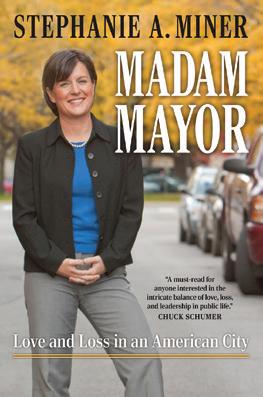
“In vivid words, the first female mayor of a major New York State city takes readers inside government and inside the sometimes smarmy world of politics. She leaves us with a memorable portrait of a brave woman battling to save both her city and her lofty ideals.”
Ken Auletta, columnist of the Annals of Communications for The New Yorker and author of Hollywood Ending: Harvey Weinstein and the Culture of Silence
“Stephanie Miner understands that local leadership is about solving problems, not playing partisan politics. Her memoir offers a behind-the-scenes look at the challenges mayors face in taking on the toughest issues facing the country—and the progress that can be made with pragmatic and fearless leadership.”
Michael R. Bloomberg, founder of Bloomberg Philanthropies and Bloomberg L.P. and 108th Mayor of New York City
“A must-read for anyone interested in the intricate balance of love, loss, and leadership in public life.”
Chuck Schumer
Madam Mayor Love and Loss in an American City
Stephanie A. Miner
Elected the first woman of a major city in New York State, Stephanie Miner gives readers an inside look at the complexity of public policy and how the political system favors Goliath-like insiders who amass power by giving easy answers over the David-like reformers who attempt to challenge the status quo. Madam Mayor is the story of what happens when personal values about honesty and integrity confront the hard reality of money and power.
More than a political memoir of a pathbreaking career, Miner’s book is also a front-row seat to the inner workings of local elections, mayoral politics, and municipal policymaking. Miner dives deep into the key policy areas that shaped her time as mayor of Syracuse and continue to affect most local politicians across the country: education, police, infrastructure, pensions, and economic development. Among other things, she writes frankly about the ugly injustices pervading the public education system, the pressure to not ask questions about fiscal policy, the challenges of making necessary infrastructure repairs that are not as sexy as splashy building projects, and the political turmoil that came with writing a New York Times op-ed criticizing the governor. Miner shows how difficult it is to navigate such complex matters when there are so many vested interests seeking to sway those in power toward one side or another.
Miner’s story sheds light on the myriad tensions between municipal and state politics, the challenges of achieving meaningful change at the local level, and the systemic obstacles to creating political change—as illustrated in her ill-fated bid to challenge the political Goliath: Governor Andrew Cuomo.
If Stephanie Miner’s illuminating stories of her time as Madam Mayor reveal anything, it is that, when supported and allowed to be creative, local governments exist to solve problems.
Stephanie Miner was the fifty-third mayor of the City of Syracuse (2010–2017) and a candidate for New York State governor in 2018. She is now the Charles Evans Hughes Visiting Chair of Government and Jurisprudence in the Department of Political Science at Colgate University, an advisor to the Bloomberg Harvard City Leadership Initiative, and a director for the Volcker Alliance.
MARCH
312 pages, 25 photographs, 6 x 9 Hardcover ISBN 978-0-7006-3828-4, $32.99 (t) Ebook ISBN 978-0-7006-3829-1, $32.99
Never Quit
How One Man Overcame Adversity to Become America’s Greatest Miler
Glenn Cunningham
Edited by Robert B. Gregg with Cindy Cunningham Foreword by Jim Ryun
Glenn Cunningham (1909–1988), a world-champion middle-distance runner, is considered by many the best American miler of all time. When Cunningham was seven, a fire in his school in Rolla, Kansas, left him so badly burned he was never expected to walk again. Doctors feared infection and wanted to amputate both legs. He would be bedridden for almost two years. But with courage, tenacity, and faith, he eventually became the world record holder for the mile.
After setting a new state record for the mile as a high school senior, Cunningham enrolled at the University of Kansas in 1930. He became the university’s first NCAA track champion and ran the 1500-meter event at the 1932 summer Olympics in Los Angeles—a celebrity while only a junior in college. In 1934 Cunningham set the world record for the mile, and in 1936 returned to the Olympic stage at the historic Berlin games. In 1974 he was inducted into the National Track and Field Hall of Fame, and in 1978 he was honored as the most outstanding track and field athlete to perform in Madison Square Garden’s 100-year history.
Cunningham’s monumental life, told in his own words, will resonate with Kansans, athletes, and anyone who finds hope in the resilience of the human spirit.
Robert B. Gregg is a producer, screenwriter, novelist, and journalist. He wrote the screenplay for and produced the film Jack London’s Love of Life, based on London’s short story.
Cindy Cunningham, Glenn Cunningham’s daughter, was born in Cedar Point, Kansas. She lives in Mexico, but considers Cedar Point her hometown.
Wichita native Jim Ryun represented Kansas’s 2nd district in the US Congress from 1996 to 2007. He was the first high school student to break the four-minute barrier in the mile run, and represented the United States at the 1964, 1968, and 1972 Olympics. Ryun was inducted into the National Track & Field Hall of Fame in 1980.
MAY
100 pages, 5½ x 8½
Paperback ISBN 978-0-7006-3891-8, $24.99 (t)
Ebook ISBN 978-0-7006-3892-5, $14.99

“Glen Cunningham was among the very few middle distance runners whose story truly inspired me to stay the course. He helped me understand that the height of competition was not for me to compete against you, but for me to reach inwardly and compete against myself to the greatest extent possible.”
Billy Mills, coauthor of Wings of an Eagle: The Gold Medal Dreams of Billy Mills
“As a schoolboy in Kansas, I grew up fascinated by the story of Glenn Cunningham, who went on to become a legendary miler at the University of Kansas, a world-record holder, and Olympic medalist. However it wasn’t his incredible achievements and accolades that made him a legendary figure. It was his journey to stardom from humble beginnings and through unimaginable adversity and tragedy that made him an icon. The story of Glenn Cunningham, captured in his own words, will inspire runners of any age as it inspired me. In an era of flashy athletic stars and instant gratification, Never Quit is a refreshing and humbling reminder of the timeless virtues of true commitment, honor, and integrity.”
David Johnston, University of Kansas 1994 Cross Country All-American and Team Captain

“Stout and Corke have assembled some of the most important voices in intelligence history to write about one of the most interesting museums in the world. In doing so, they have found the elusive Goldilocks zone: the book is not too hot (pedantic, academic . . . boring) for the general public (or museum visitor), and not too cold (watered down) for the professional intelligence historian. It lives in that special space that makes it accessible and enjoyable for all audiences. Like the comfiest chairs, the best beds, and the tastiest porridges, Secrets on Display is just right.”
Vincent J. Houghton, director of National Cryptologic Museum
Secrets on Display Stories and Spycraft from the International Spy Museum
Edited by Mark Stout and Sarah-Jane Corke
Secrets on Display takes readers on a tour of the thrilling, real-life history of intelligence and espionage from around the world. With tales of spies, codebreakers, moles, terrorist-hunters, spy chiefs, propagandists, and secret agents, these new histories uncover a world that many of us only see in the movies. Bringing together stories and artifacts from the International Spy Museum in Washington, DC, this book makes the world’s largest museum devoted to intelligence history accessible to everyone.
Secrets on Display brings this hidden history to life with over 200 photographs, including nearly 100 color images of artifacts—among them, James Bond’s Aston Martin DB5, the axe used to assassinate Leon Trotsky, a portion of the secret MI6 and CIA tunnel beneath East Berlin, and a precursor to the Predator drone, as well as concealment devices, secret cameras, disguise kits, cipher machines, and a host of other rare objects seldom seen by the public.
These stories, told by historians, intelligence officers, and museum professionals, will fascinate scholars, intrigue practitioners, and entice those interested in a world of secrecy that most of us can scarcely imagine.
Mark Stout is a former senior lecturer and director of the Master of Arts in Global Security Studies program at Johns Hopkins University, and a former intelligence officer. His books include World War I and the Foundations of American Intelligence, also published by Kansas.
Sarah-Jane Corke is associate professor of historical studies at the University of New Brunswick. She is the author of US Covert Operations and Cold War Strategy: Truman, the CIA and Secret Warfare.
JUNE
360 pages, 57 photographs, 6 x 9 Hardcover ISBN 978-0-7006-3880-2, $39.99 (s) Ebook ISBN 978-0-7006-3881-9, $39.99
Armies Afloat
How the Development of Amphibious Operations in Europe Helped Win
World War II
John M. Curatola
American forces storming the beaches of Normandy on D-Day, June 6, 1944, is one of the most famous moments in US military history. But behind this iconic assault is the long-overlooked history of learning and innovation. Significantly, the amphibious forces taken ashore that day were overwhelmingly army soldiers, with sailors and airmen in support. Before the army could launch such an endeavor, however, it had to learn how to conduct amphibious operations against a contested shore. Creating this capability required a concerted, deliberate effort. Involving an extensive joint endeavor of air, naval, and ground forces, amphibious assault strategy developed over the course of four years. In Armies Afloat, John Curatola leads readers through US Army’s amphibious development and capabilities by examining six components: command relationships, ship-to-shore movement, naval surface fire support, air support, beachhead establishment, and logistics and communication. The men, material, processes, and coordination involved in developing such a large-scale amphibious capability was something truly new in warfare. Through a constant process of assessment and review, US forces adjusted methodologies at all levels of war and successfully outpaced—and ultimately defeated—the European Axis powers.
John Curatola is Samuel Zemurray-Stone Senior Historian at the National World War II Museum and served as a Marine Corps officer for twenty-two years. He is the author of Bigger Bombs for a Brighter Tomorrow: Strategic Air Command and American War Plans at the Dawn of the Atomic Age, 1945–1950 and Autumn of Our Discontent: Fall 1949 and the Crises in American National Security.
Modern War Studies
APRIL
376 pages, 30 photographs, 6 x 9 Hardcover ISBN 978-0-7006-3861-1, $44.99 (s) Ebook ISBN 978-0-7006-3862-8, $14.99

“Armies Afloat is the best work I’ve read on amphibious warfare in Europe. Curatola’s research is deep and his verdicts judicious. Amphibious operations are complex, the learning curve is steep, and the men at the sharp end pay the price. As Curatola shows in this indispensable book, the US military learned its lessons just in time.”
Robert M. Citino, author of Blitzkrieg to Desert Storm: The Evolution of Operational Warfare
“John Curatola has provided a detailed analysis of the development of American amphibious operations in the Mediterranean and European Theaters, focusing on the US Army, Navy, and Army Air Forces. The US Army engaged in over 140 landings in the course of World War II, providing a wealth of experience to be considered for future military options in our complex world today.”
Conrad Crane, author of American Airpower Strategy in World War II: Bombs, Cities, Civilians, and Oil
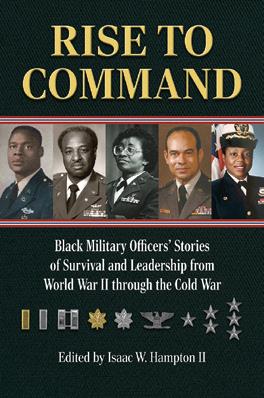
“Isaac Hampton brings his deep historical knowledge to Rise to Command. He gives us—in multiple voices, through powerful memories— stories of men and women who served their nation in uniform. This book is absolutely necessary for anyone who hopes to understand the history and significance of Black Americans in the US military.”
Beth Bailey, author of An Army Afire: How the US Army Confronted Its Racial Crisis in the Vietnam Era
“Black servicemen and women since the founding of the nation-state have fought on two fronts, first against deeply entrenched white racism and second against the enemies of the United States. Isaac Hampton, in an excellent series of oral histories, has provided us with a first-hand account of the thoughts, concerns, insights, and emotions of Black military leaders who fought on two fronts in the post–World War II era. A must-read for all students of America’s wars.”
Adrian R. Lewis, author of The American Culture of War: The History of U.S. Military Force from World War II to Operation Enduring Freedom
Rise to Command Black Military Officers’
Stories of Survival and Leadership from World War II through the Cold War
Edited by Isaac W. Hampton II
Rise to Command is a social history told in the words of seventeen Black military officers who grew up in the Jim Crow era and served in the US military. The officers speak candidly about their careers and struggles and the important lessons they learned from their communities, which helped them succeed.
Black Americans in the armed forces fought on two fronts: one against America’s external adversaries on the battlefield, and the other against racial discrimination and segregation within military culture and American society. The officers discuss living through segregation, the civil rights movement, and the Black Power movement. These torchbearers speak frankly about the racially biased officer evaluation system, gender discrimination, and how they survived and thrived despite systemic obstacles.
Rise to Command examines the evolution of policies and cultural dynamics within the US military, with a critical focus on the complexities of racial integration and equity. It not only traces the history of change but also underscores the persistent challenges that continue to shape the experiences of service members. Through the memories of Black officers, Rise to Command provides a vital perspective on the struggle for inclusivity and justice within one of America’s most enduring institutions.
The many perspectives from across the wars of the twentieth century highlight the progress these soldiers fought for—from total segregation during World War II to the deployment of America’s first racially integrated military force during the Vietnam War. Although these officers may not have known it, they were blazing the trail for the next generation of Black Americans, in and out of military service.
Isaac W. Hampton II is a historian for the United States Army. He is a US Army veteran and the author of The Black Officer Corps: A History of Black Military Advancement from Integration through Vietnam.
JUNE
256 pages, 31 photographs, 1 table, 6 x 9 Hardcover ISBN 978-0-7006-3882-6, $32.99 (t) Ebook ISBN 978-0-7006-3883-3, $14.99
Counting Like a State
How Intergovernmental Partnerships Shaped the 2020 US Census
Philip Rocco
The census plays a foundational, if all too easily ignored, role in the operation of the American state, shaping everything from congressional representation to the allocation of trillions of federal dollars. While census taking aspires to the high-modernist goal of “seeing like a state”— centralizing, standardizing, and homogenizing knowledge about a polity— it is subject to far more conflict and negotiation than final tabulations, maps, or technical documentation make apparent. This is especially true in a large, decentralized polity like the United States where the Constitution entrusts the ultimate authority for the census in the legislative branch.
In Counting Like a State, Philip Rocco shows how the production of the US census now hinges crucially not only on what happens in Washington but also on a series of intergovernmental partnerships. State and local officials, though not formally responsible for census taking, figure importantly in the implementation of the decennial count. These officials are essential partners in the construction and maintenance of address lists, as well as in outreach and promotion campaigns in hard-tocount communities. The 2020 Census compounded these challenges with new crises. Intergovernmental partnerships played a key role in preventing President Trump from adding a citizenship question, as state and local officials mounted a coordinated legal counteroffensive. Many local officials also simply refused to cooperate with the Trump administration’s efforts to exclude undocumented immigrants from the apportionment count. The census also took place in the context of a global pandemic that stretched administrative resources to the breaking point. While these partnerships allowed the Census Bureau to adapt to ever-changing conditions on the ground, state and local governments also sounded the alarm when the Trump administration sought to rush the census. These efforts helped preserve the quality of the data collected in the 2020 count.
Rocco’s illuminating study of the 2020 Census pulls back the curtain on the administrative state to reveal how something as complex and centralizing as a census takes place within a decentralized, federalist system. Drawing on analyses of interviews with hundreds of public officials and quantitative analyses of state and local census activities, Counting Like a State allows scholars and practitioners to better understand what facilitates as well as what impedes effective intergovernmental partnerships for census taking.
Philip Rocco is associate professor of political science at Marquette University and coauthor of Obamacare Wars: Federalism, State Politics, and the Affordable Care Act
JUNE
304 pages, 2 photographs, 6 maps, 14 figures, 6 x 9
Hardcover ISBN 978-0-7006-3875-8, $54.99 (x)
Paperback ISBN 978-0-7006-3876-5, $29.99 (x)
Ebook ISBN 978-0-7006-3876-5, $29.99

“Philip Rocco has produced a highly readable and thought-provoking analysis of the importance of state and local governments in the effective conduct of the modern US census—a linchpin for our democracy. He makes a strong case for strengthening the intergovernmental partnerships that are so vital for a fair and accurate count.”
Constance F. Citro, coauthor of The Nation’s Data at Risk: Meeting America’s Information Needs for the 21st Century
“Rocco’s study offers an in-depth look at the intergovernmental relationships that guided the conduct of the 2020 Census, particularly the diverse ‘Get Out the Count’ outreach campaigns in local areas around the country. He has added important new insights into the fraught issues the country faced as Americans took a census during a pandemic. The book should be widely read by the many ‘stakeholders’ in successful census taking, be they social scientists and statisticians, political leaders, or ordinary Americans.”
Margo J. Anderson, author of The American Census: A Social History

“In this well-written, well-researched, and timely book, Joe J. Ryan-Hume documents the legislative successes that liberals had during the ‘Age of Reagan.’ He concludes that far from failing to meet the challenge of the 1980s, liberalism redefined itself and built coalitions that were essential to their electoral victories in the 1990s and 2000s. I highly recommend giving this important book a read.”
Marcus M. Witcher, author of Getting Right with Reagan: The Struggle for True Conservatism, 1980–2016
“Using a refreshing blend of intellectual, institutional, social, and cultural histories, Ryan-Hume rethinks the meaning of political success through a non-traditional lens that prioritizes alternative power structures and activist voices frequently ignored in popular and scholarly understandings of the decade. In essence, he shows that liberals not only survived the Reagan years but, depending on how you define it, thrived. Without discounting conservatism’s growing popularity during these years, Ryan-Hume shows that liberalism remained viable, vibrant, and frequently victorious.”
Sean P. Cunningham, author of Bootstrap Liberalism: Texas Political Culture in the Age of FDR
Resisting Reagan
Liberal Strategies in a Conservative Age
Joe J. Ryan-Hume
“Liberalism is at a crossroads. It will either evolve to meet the issues of the 1980s or it will be reduced to an interesting topic for Ph.D.-writing historians.” So stated the young Massachusetts Senator Paul Tsongas in June 1980 in the keynote address before the liberal organization Americans for Democratic Action. Tsongas’s statement was a bracing critique of the liberal establishment and a call to creative action in the face of the new economic, social, and political realities that had engulfed the country since the 1960s. While liberal leadership failed to pivot enough to maintain the presidency—many were shocked by and dismissive toward Tsongas’s message—Ronald Reagan’s election forced Democrats to change their approach.
According to a widespread consensus, the country during the Reagan era moved inexorably to the Right as liberalism experienced a sustained period of decline and marginalization. On this view, an increasingly dominant conservative movement overwhelmed “New Deal” liberalism and forced Democrats to retreat or accommodate the new conservative order. Drawing on a wealth of archival research, Joe J. Ryan-Hume argues that liberalism had far more success during this period than historical orthodoxy would suggest. Ryan-Hume examines how grassroots liberal organizations—such as NOW, NARAL, and the Leadership Conference on Civil Rights—reformed their strategies in the wake of the Reagan Revolution to remain influential. By focusing on the nexus of grassroots activism, political ideology, and party politics, Resisting Reagan reveals the complex reorientation of liberalism and the Democratic Party in the 1980s. In doing so, it illuminates how the changing activist and electoral coalition reshaped the Democratic Party’s political priorities, how liberal grassroots organizations creatively advanced their policy objectively, and how liberals pragmatically brokered legislation to protect or advance liberalism in an increasingly anti-government environment.
Liberals survived the Reagan era, according to Ryan-Hume, by changing tone instead of substance, building powerful coalitions, and designing new strategies to exploit emerging trends. By looking at 1980s politics from the bottom up, Resisting Reagan offers a surprising view at a period that offers lessons for today.
Joe J. Ryan-Hume is a Fulbright scholar and a senior researcher at the UK Parliament.
JUNE
160 pages, 5½ x 8½
Hardcover ISBN 978-0-7006-3877-2, $69.99 (x)
Paperback ISBN 978-0-7006-3878-9, $27.99
Ebook ISBN 978-0-7006-3879-6, $27.99
Beyond Black Hawk Down
Intervention, Nation-Building, and Insurgency in Somalia, 1992–1995
Jonathan Carroll
The story of Black Hawk Down is a familiar one. On 3 October 1993 two Black Hawk helicopters were shot down, and in the ensuing Battle of Mogadishu eighteen Americans and hundreds of Somalis were killed. But very few appreciate that this was just one day in a two-and-a-half-year operation; the most ambitious attempt in history to rebuild a nation. The United States sought to show the world that the UN could rebuild a country, but in a dire foreshadowing of the failed efforts in Iraq and Afghanistan a decade later, the intervention in Somalia was plagued with political infighting, policy mismatch, confusion, and fatal assumptions.
In 1992 Somalia saw the largest ever deployment of American troops to the continent of Africa, and 1993 brought the first UN-led peace enforcement mission and the most ambitious experiment in nation-building. In Beyond Black Hawk Down, Jonathan Carroll provides the first scholarly military history of the entire intervention, from its early and largely successful humanitarian phase in 1992 through to the ultimate withdrawal of UN forces in 1995. Carroll dispels the myths and misunderstandings surrounding one of the most infamous episodes of the 1990s to present a new interpretation of events, most notably by including the Somali perspective, to argue what went so wrong in Somalia, and more importantly, why.
Understanding the intervention in Somalia, its successes and the roots of its failures, is invaluable to contemporary debates on concepts of nation-building and counterinsurgency. Moreover, the increasing regularity of inter-state and intra-state conflicts across the world means the international community will continue to be called upon to intervene in other failed or failing states in the future. Beyond Black Hawk Down is an important new history that will inform the shape and nature of future military interventions.
Jonathan Carroll is a former officer in the Irish Defence Forces who earned a PhD from Texas A&M University. He is an associate professor of military history at the Royal Military Academy, Sandhurst.
Modern War Studies
JUNE
464 pages, 24 photographs, 20 maps, 6 x 9
Hardcover ISBN 978-0-7006-3888-8, $54.99 (x)
Ebook ISBN 978-0-7006-3889-5, $54.99

“Jonathan Carroll has written an excellent account of the US/UN intervention in Somalia. His insightful and thoroughly researched work provides an in-depth analysis of the complex nature of military interventions. The lessons he draws should be studied by political leaders and generals contemplating these kinds of operations.”
General Anthony C. Zinni USMC (Retired), coauthor of Leading the Charge: Leadership Lessons from the Battlefield to the Boardroom
“Based on meticulous research in newly available archival records, Jonathan Carroll’s incisive myth-busting account of international intervention in Somalia offers an invaluable contribution to the military history of the 1990s.”
Brian Drohan, author of Brutality in an Age of Human Rights: Activism and Counterinsurgency at the End of the British Empire
“Carroll uses many never-before-seen sources to bust the key myths about the complex and often misunderstood international military intervention in Somalia between 1992 to 1995.”
Thijs Brocades Zaalberg, coauthor of Empire’s Violent End: Comparing Dutch, British, and French Wars of Decolonization, 1945–1962

“Douglas Bristol’s detailed and deeply researched history of African American military labor during World War II shines much-needed light on a crucial, but neglected aspect of the Black experience. On the home front and in every theater of war, African Americans performed much of the labor that not only sustained US military power but that also helped lay the groundwork for the postwar civil rights movement.”
Chris Dixon, author of African Americans and the Pacific War, 1941–1945: Race, Nationality, and the Fight for Freedom
“The significant contributions of Black Americans in the wars of the United States have too frequently been omitted, deleted, and distorted in the history books. In a new, excellent, revealing study, Bristol demonstrates that ‘Black GIs . . . made themselves indispensable to keeping the American war machine running around the globe,’ and in the process made possible decisive victories in World War II, and in the postwar civil rights movement.”
Adrian R. Lewis, author of The American Culture of War: The History of U.S. Military Force from World War II to Operation Enduring Freedom
Building Bridges
Black GIs, Military Labor, and the Fight for Equality in World War II
Douglas Bristol
More than 80 percent of Black GIs in World War II served behind the front lines. At the beginning of the war, segregation policies maintained physical separation of Black and white GIs and only allowed Black soldiers to do simple, menial work, maintaining a false sense of racial inferiority. But the mechanization of armed forces during World War II demanded more skilled laborers behind the front lines. The Army Service Forces, created in March 1942, turned to Black GIs to solve the serious manpower shortage and trained them for jobs previously done only by white GIs. In Building Bridges, author Douglas Bristol tells the story of how military necessity led to unprecedented changes in the employment of Black troops. These changes had unanticipated consequences. American military leaders adopted a new racial discourse that emphasized the rights and potential of Black GIs. The new opportunities also exposed racial discrimination, giving Black GIs and their allies more leverage to demand better treatment.
Black GIs built bridges, roads, and runways. They repaired engines and radios. They transported bombs, bullets, food, gasoline, and water to hard-pressed soldiers on the front lines. Their numbers, skills, and necessity only grew as the war continued. By the end of the World War II, Black GIs had cracked the glass ceiling in the racialized military hierarchy behind the front lines and became indispensable to keeping the American war machine running around the globe.
Douglas Bristol is associate professor of history and a fellow of the Dale Center for the Study of War and Society at the University of Southern Mississippi. He is the author of Knights of the Razor: Black Barbers in Slavery and Freedom and coeditor of Integrating the U.S. Military: Race, Gender, and Sexuality since World War II.
Studies in Civil-Military Relations
JUNE
216 pages, 6 x 9
Hardcover ISBN 978-0-7006-3900-7, $49.99 (x) Ebook ISBN 978-0-7006-3901-4, $49.99
Lincoln’s Last Card
The Emancipation Proclamation as a Case of Command
Richard J. Ellis
There is a certain comfort in being able to see Lincoln—or any president—simply as either a hero or a villain. The truth, however, is more complicated. Lincoln’s Last Card helps us look beyond the myths to see Lincoln as the flawed and consequential leader that he was.
Few presidential edicts are more famous or misunderstood than the Emancipation Proclamation. The traditional myth about the proclamation is that President Lincoln freed the slaves with a bold stroke of his pen. This popular understanding deifies Lincoln as the sagacious Great Emancipator and constructs a narrative of American history centered around the heroic deeds of our “great” presidents. A more cynical view, bolstered by recent historical examinations of Lincoln’s own racial biases, says the proclamation was much ado about nothing; a largely hollow gesture that freed no slaves at all and lacked even a moral indictment of slavery. Both views, however, see presidential power as largely unrestricted and unilateral, so that Lincoln’s decisions occur in a virtual vacuum—a timeless display of his moral virtue, or lack thereof.
Richard Ellis, a veteran scholar of the American presidency, suggests that we look at Lincoln’s proclamation through the lens of presidential weakness rather than greatness. To do so, Ellis draws on the work of renowned political scientist Richard Neustadt, who explored “three cases of command” from the twentieth century in his 1960 work, Presidential Power. Where the public saw presidential success, Neustadt saw presidents engaged in “a painful last resort,” suggesting not political mastery but rather the failure to achieve goals through other means. Ellis applies this same perspective to the Emancipation Proclamation, showing how Lincoln’s great success was, in fact, his last card. Lincoln’s original hope was to persuade the border states to endorse his plan for gradual, compensated abolition, preferably coupled with some level of voluntary colonization. Contrary to conventional wisdom and in contrast to Lincoln’s reputation as the greatest presidential orator, Ellis shows how the Emancipation Proclamation was a sign of Lincoln’s failure to persuade.
Richard J. Ellis is Mark O. Hatfield Professor of Politics, Policy, Law, and Ethics at Willamette University in Salem, Oregon. His previous books include Old Tip vs. the Sly Fox: The 1840 Election and the Making of a Partisan Nation and Presidential Lightning Rods: The Politics of Blame Avoidance
Landmark Presidential Decisions
FEBRUARY
168 pages, 5½ x 8½
Hardcover ISBN 978-0-7006-3812-3, $69.99 (x)
Paperback ISBN 978-0-7006-3813-0 $27.99 (x)
Ebook ISBN 978-0-7006-3814-7, $27.99

“In Lincoln’s Last Card, Richard J. Ellis retells the story of Lincoln’s Emancipation Proclamation in a fresh and powerful way, by highlighting the extraordinarily difficult constraints under which Lincoln acted. Emancipation by presidential proclamation was Lincoln’s ‘last card’ because he had already exhausted every less risky course of action. Ellis persuasively shows how Lincoln’s greatness lay in his willingness to try, and fail, and try again.”
James H. Read, author of Sovereign of a Free People: Abraham Lincoln, Majority Rule, and Slavery
“In a well-written and argued book, Richard Ellis has provided a new and important interpretation of Lincoln’s historic decision for emancipation. He writes that the Emancipation Proclamation was a ‘painful last resort’ by Lincoln to achieve his antislavery objective after his attempts at persuasion had failed. Anyone interested in the ending of slavery and Lincoln’s pre-eminent role in it should want to read this book.”
William C. Harris, author of Lincoln Illuminated and Remembered

“A Violent Peace reinvigorates interwar military history. By combining operational military history and war and society approaches while blending national and global perspectives it allows the interwar era to emerge from the shadows of the World Wars. It is essential reading for military historians, scholars of the twentieth century, and students of modern warfare.”
Andrew Orr, author of Facing the Victorious Turks: How the French Misread the Turkish War of Independence
“This book focuses on the violent history of imperial powers in the years between the two world wars. Exploding the outdated notions both of an ‘interwar period’ and of a ‘30 years war,’ these essays provide a subtle and powerful narrative of the military history of conflicts underway before 1914 and still in motion after 1945. This book should be read by anyone interested in the ‘phantom years of peace’ of the first half of the twentieth century.”
Jay Winter, author of War Beyond Words: Languages of Remembrance from the Great War to the Present
A Violent Peace A Global Military History of the Interwar Period
Edited by Ian Ona Johnson and Robert Clemm Foreword by Robert M. Citino
World War I destroyed the world that had come before. It shattered three empires and fueled new nationalisms and ideologies that threatened to destroy those that remained. It left millions in its wake with military training and access to weaponry, creating networks of violence that would spread across much of the globe. This violence in the interwar period resulted in more deaths than during the Great War, most of them outside of Europe.
While studies of the First and Second World Wars have become more international and interconnected, our understanding of the interwar period remains dominated by national narratives. A Violent Peace offers a new perspective, stretching across four continents and drawing together a multitude of conflicts, large and small: from the Spanish Civil War to the Wewel Incident in Ethiopia; from the small RAF force involved in Somaliland to the hundreds of thousands in the Chinese Nationalist Encirclement Campaigns; from the conflicts surrounding newly formed states in the Polish-Soviet War to a settling of much older accounts in South America. The themes and patterns from this global era are drawn together in a cohesive analysis, including key studies on the utilization of technology, the growing importance of ideology, and how the Great War shaped the nature of these conflicts.
A Violent Peace provides a fresh angle on a tumultuous era and challenges readers to reconsider their preconceived ideas about the interwar period.
Ian Ona Johnson is P. J. Moran Family Associate Professor of Military History at the University of Notre Dame. He is the author of Faustian Bargain: The Soviet-German Partnership and the Origins of the Second World War
Robert Clemm is Associate Professor of Strategy in the Global College of Professional Military Education at Air University.
Modern War Studies
JUNE
336 pages, 12 maps, 6 x 9 Hardcover ISBN 978-0-7006-3873-4, $54.99 (x) Ebook ISBN 978-0-7006-3874-1, $54.99
Commerce and Character
The Political Economy of the Enlightenment and the American Founding
Edited by Steven Frankel and John Ray
In his 1979 article, “Commerce and Character: The Anglo-American as New-Model Man,” Ralph Lerner argued that the American Founders and the political theorists of the commercial republic were charting a new basis for society that broke with the “old order,” which was “preoccupied with intangible goods to an extent we now hardly ever see. The king had his glory, the nobles their honor, the Christians their salvation, the citizens of pagan antiquity their ambition to outdo others in serving the public good.” By contrast, the commercial republic was a regime based on the belief that human behavior is best understood as driven by physical wants and tangible goods. A government grounded on this understanding of humanity would be a more stable system and thus more conducive to human flourishing. Lerner’s article thus interpreted the Founding as a revolution in political philosophy that must be understood against the backdrop of the Enlightenment.
Commerce and Character brings together nine distinguished scholars who explore individual Enlightenment or American thinkers who made important philosophical or political contributions to the new political economy of modern republicanism. The contributing authors include Ann Charney Colmo, Ryan Hanley, John C. Koritansky, Peter McNamara, Peter Onuf, Clifford Orwin, Paul Rahe, Colleen Sheehan, and Michael Zuckert. Each contributor uses Lerner’s essay as the jumping-off point, and at the end, Lerner provides a detailed response to each of his interlocutors where he carefully examines each chapter and reconsiders his arguments a half century later.
Steven Frankel is professor of philosophy and Stephen Smith Professor of Political Economy at Xavier University as well as coeditor of Civil Religion in Modern Political Philosophy: Machiavelli to Tocqueville and Equality and Excellence in Ancient and Modern Political Philosophy.
John Ray is associate professor of political science at Xavier University and coeditor of Equality and Excellence in Ancient and Modern Political Philosophy.
American Political Thought
MARCH
272 pages, 6 x 9
Hardcover ISBN 978-0-7006-3830-7, $69.99 (x)
Paperback ISBN 978-0-7006-3831-4 $27.99 (x)
Ebook ISBN 978-0-7006-3832-1, $27.99

“This volume provides a rich conversation on the relationship between commerce and virtue in the age of the modern commercial republic through the lens of Ralph Lerner’s seminal essay ‘Commerce and Character: The Anglo-American as New-Model Man.’ The reader is treated to an illuminating discussion of sometimes competing and sometimes complementary views regarding how Enlightenment philosophers shaped and understood the limitations of modern commercial regimes led by Lerner and nine other renowned scholars of political philosophy.”
Andrea Radasanu, coeditor of In Search of Humanity: Essays in Honor of Clifford Orwin
“In curating a collection of essays on the philosophic progenitors of the commercial republic and the founders of the American republic and its great French interpreter, the perspicacious editors of Commerce and Character do justice to the influential essay of the same title that serves as their prologue by Ralph Lerner, from whose writing and teaching so many have learned so much.”
Nathan Tarcov, coeditor of The Legacy of Rousseau

“This volume marks a long stride forward in scholarly work on the nexus between environmental and military matters, with new research and novel insights on the Pacific War, the Vietnam War, and nuclear weapons testing. It brings together a broad variety of approaches to environmental history, matching the broad diversity of Pacific environments and peoples.”
J. R. McNeill, coauthor of The Great Acceleration: An Environmental History of the Anthropocene since 1945
“This is a rich collection of original essays that critically examine the destructive effects of US imperial expansion on varied Pacific environments, their populations, and non-human life forms from World War II to the Vietnam War. The contributions to this well-researched volume underscore the connection between scientific knowledge and state power, the reciprocal interaction between the US military and the environments it sought to conquer, the power of discursive imaginaries centered on ecological devastation, and the resistance of local and Indigenous people. The result is a compelling intervention on the relationship between war and the environment.”
David Hanlon, author of Making Micronesia: A Political Biography of Tosiwo Nakayama
The US Military and the Pacific Environment
The Making of an American Lake
Edited by Andrew C. Isenberg, Beth Bailey, and Paul Landsberg
Oceans and deserts, jungles and plains, mountains and rivers, monsoons and blizzards, fertile grounds and diseased lands; all have shaped how strategy and technology has been deployed and developed, and all have supported unexpected victories and decimated even the best-laid plans. Conversely, warfare and militarization have shaped the environment, scarring landscapes, accelerating the global spread of disease, unbalancing ecosystems, and contributing to climate change.
Reflecting on the inextricable, reciprocal, and often surprising relationship between the natural world and human warfare, these essays offer a new perspective on power, knowledge, and the environment in US military history.
The history of US military engagement in the Pacific powerfully demonstrates the profound and diverse impacts that regions’ extraordinarily diverse environments have wrought on warfare. US military action has also had profound impacts in the Pacific, from the nuclear weapons testing programs of the Cold War to the use of chemical defoliants in Vietnam. The contributors to this volume consider how the physical environments of the Pacific shaped the process and outcome of battles and wars, and discuss the effect warfare and other military actions had on these physical environments.
Andrew C. Isenberg, the Hall Distinguished Professor of American History at the University of Kansas, is the editor of The Oxford Handbook of Environmental History
Beth Bailey is Foundation Distinguished Professor and director of the Center for Military, War, and Society Studies at the University of Kansas.
Paul Landsberg is an assistant professor in the Department of History at the United States Air Force Academy.
Modern War Studies
JUNE
312 pages, 17 photographs, 6 x 9 Hardcover ISBN 978-0-7006-3870-3, $54.99 (x) Ebook ISBN 978-0-7006-3871-0, $54.99
War Underground A History of Military Mining in Siege Warfare
Earl J. Hess
From as early as ancient Greek, Roman, and Chinese warfare to the battles of World War I, military mining was an essential component of siege warfare. Armies have tunneled underneath castle walls, dug trenches across no-man’s-land, and engineered confusing defensive countermines. These tactics for assaulting enemy fortifications and positions by creating underground access have adapted to changes in warfare, technology, geography, and culture. While its use diminished after 1918, when speed and movement took precedence over capturing strongpoints, military mining remains a viable strategy still deployed to this day. Although military historians have given mining marginal treatment in virtually every study of siege warfare, it has not yet been treated with depth or comprehensiveness as a subject in its own right. In this first book-length study of the subject, renowned military historian Earl Hess now fully addresses the topic of military mining from its earliest origins to the twenty-first century.
In War Underground, Hess offers a sweeping study of the use of offensive and defensive military mining in more than 300 sieges from around the world and across almost three millennia. The result is an impressively broad and comprehensive treatment of the grand history of military mining, which offers novel insights to the evolution and trajectory of the strategy since its ancient origins.
Earl J. Hess is professor emeritus at Lincoln Memorial University. He is the author of thirty-six books, including Civil War Field Artillery: Promise and Performance on the Battlefield and, most recently, July 22: The Civil War Battle of Atlanta, with Kansas.
FEBRUARY
376 pages, 38 photographs, 1 table, 6 x 9
Hardcover ISBN 978-0-7006-3841-3, $54.99 (x) Ebook ISBN 978-0-7006-3842-0, $54.99

“Military mining is the ultimate method of siege breaking, a technique employed since ancient times. With the dawn of industrial warfare, offensive mining reached its peak, helping to break the WWI trench lines. In Earl J. Hess’s remarkable survey of underground warfare we see it all; an eminently readable yet scholarly account that should be standard reading for all those interested in the topic.”
Peter Doyle, author of Disputed Earth: Geology and Trench Warfare on the Western Front, 1914–18
“Fortification and siege craft are key facets of warfare from antiquity to the present. Hess provides an excellent guide to the subject focusing on key episodes. As the author of two other books on the subject, I can only say how sorry I am that War Underground was not available for me to make reference.”
Jeremy Black, author of Military Strategy: A Global History
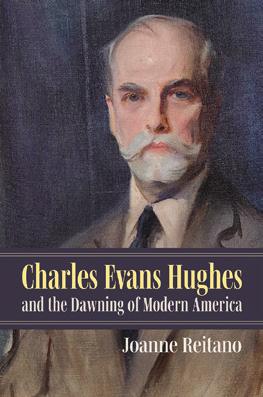
“Reitano provides an elegant and concise summary of Hughes’s long, sprawling, and multi-faceted career, a task that is so formidable that nearly all previous biographers have explored only parts of Hughes’s life. Reitano is at home in discussing politics, governance, diplomacy, and constitutional law in ways that make the book useful for scholars and highly accessible to general readers. She relates Hughes’s life to issues that remain important today, while avoiding political polemics or presentism.”
William G. Ross, author of The Chief Justiceship of Charles Evans Hughes, 1930–1941
“There may not be a more important, neglected major figure in American political history than Charles Evans Hughes—governor, defeated presidential nominee, secretary of state, and chief justice. Like her subject, Reitano is never boring as she deftly and thoroughly explains Hughes’s wide-ranging accomplishments and revealing limitations.”
Michael McGerr, author of A Fierce Discontent: The Rise and Fall of the Progressive Movement in America, 1870–1920
Charles Evans Hughes and the Dawning of Modern America
Joanne Reitano
In the first full-life biographical study of Charles Evans Hughes in over seventy years, Joanne Reitano provides a fresh assessment of Hughes’s distinguished, multifaceted public service during the first half of the twentieth century. His exceptional career included the roles of governor of New York (1906–1910), associate justice and presidential candidate (1910–1916), secretary of state (1921–1925), and chief justice of the Supreme Court (1930–1941).
A household name in his own time, Hughes challenged bossism in New York politics, championed post–World War I internationalism, and brokered the world’s first arms limitation agreement. On the Supreme Court, he was instrumental in modernizing legal doctrines concerning the interstate commerce clause, substantive due process, and civil liberties. Reitano unpacks the seemingly paradoxical nature of Hughes’s political and legal careers, arguing that he was neither radical nor reactionary, but a structural reformer and a practical idealist who significantly impacted the nation’s transition into the twentieth century.
Drawing on a wealth of sources, Reitano’s work will be the definitive account of Charles Evans Hughes for years to come.
Joanne Reitano is professor emerita of history at LaGuardia Community College, CUNY. Her publications include The Tariff Question in the Gilded Age: The Great Debate of 1888, The Restless City: A Short History of New York from Colonial Times to the Present, and New York State: Peoples, Places, and Priorities.
JUNE
400 pages, 22 photographs, 6 x 9 Hardcover ISBN 978-0-7006-3886-4, $54.99 (x) Ebook ISBN 978-0-7006-3887-1, $54.99
Dartmouth College v. Woodward Colleges, Corporations, and the
Common Good
Adam R. Nelson
Dartmouth College v. Woodward examines the landmark case decided by the United States Supreme Court in 1819 after New Hampshire’s state legislature attempted to amend Dartmouth’s charter to place the college under greater public control. Adam R. Nelson interprets the case not only as one about higher-education governance or American corporate law in an emerging constitutional order, and not simply as a case about the Marshall Court’s preference for “private” over “public” initiative as the primary driver of social and commercial development. More fundamentally, Nelson uses the case to illustrate a broad ideological shift from commonwealth republicanism to market liberalism in both education and jurisprudence during the early nineteenth century.
The question at the heart of the case was: should Dartmouth College be subject to legislative authority? This book finds that when the state court said “yes” but the US Supreme Court said “no,” the divergence between these decisions stemmed not only from different applications of the contracts clause but also from disagreements about the degree to which core institutions in a democracy—whether colleges or churches or companies—should be overseen or regulated by political majorities. Implicit in the Dartmouth case, though never clarified, was the question of whether higher education was a private or public good, and thus whether colleges are better off under private or public control. By choosing the private path, Dartmouth reinforced a gradual privatization of what might otherwise have been considered public goods. Americans today live with the consequences of this decision.
A landmark in American corporate law, the Dartmouth College case has been cited in a wide variety of subsequent decisions, including Citizens United (2010) and Burwell v. Hobby Lobby Stores (2014). Adam Nelson’s informative work provides an accessible introduction to this important piece of American legal history.
Adam R. Nelson is Vilas Distinguished Achievement Professor of Educational Policy Studies and History at the University of WisconsinMadison. He is the author of several books, including Exchange of Ideas: The Economy of Higher Education in Early America and Capital of Mind: The Idea of a Modern American University.
Landmark Law Cases and American Society
APRIL
286 pages, 5½ x 8½
Hardcover ISBN 978-0-7006-3867-3, $69.99 (x)
Paperback ISBN 978-0-7006-3868-0 $27.99 (x)
Ebook ISBN 978-0-7006-3869-7, $27.99

“Adam Nelson offers the most readable and thorough account of the origins of the Dartmouth College case to date. By digging deep into Dartmouth’s history, he argues that the Supreme Court got the facts wrong, and in doing so transformed the relationship between corporations—especially colleges—and the public good. The decision’s impact can still be felt today.”
Johann Neem, author of Democracy’s Schools: The Rise of Public Education in America
“Despite being foundational to American constitutional law, the Dartmouth case rests on shaky, even shady foundations. Nelson breathes new life into that old tale, giving us a thorough and provocative account of the origins, meaning, and impact of this fateful decision. This is the most exciting work on the subject in generations and is sure to engage scholars and students alike.”
Benjamin Justice, coauthor of Have a Little Faith: Religion, Democracy, and the American Public School
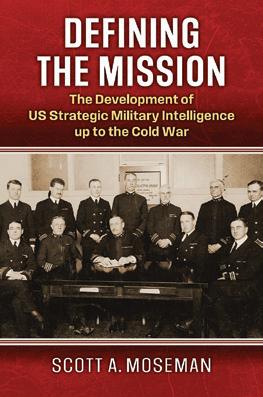
“Scott A. Moseman provides an informative and detailed account of the origin and evolution of the American armed forces’ strategic intelligence agencies from the Gilded Age to the start of the Cold War. This book will be of great interest to scholars of military organization, intelligence, and national security.”
Brian McAllister Linn, author of Real Soldiering: The US Army in the Aftermath of War, 1815–1980
“Going beyond the base facts of how intelligence bodies developed structurally, Moseman provides not only the personalities but also the politics, both partisan and bureaucratic, responsible for the halting growth of military and later political agencies through the 1940s. In peace and war, Moseman provides a fascinated description of the structure and functions of these agencies. As such, Defining the Mission should be essential reading for anyone seeking to understand the early development of the intelligence community.”
Jonathan House, author of Intelligence and the State: Analysts and Decision Makers
Defining the Mission
The Development of US Strategic Military Intelligence up to the Cold War
Scott A. Moseman
From 1882 to 1947—the year the CIA was established—strategic military intelligence organizations struggled to define their missions. The American public, government and military leaders, and intelligence professionals all had competing ideas of what military intelligence should be and do. The quest of strategic military intelligence organizations to define themselves and their mission was directly influenced by the trends of a growing American military and maturing American society in the late-nineteenth and early-twentieth centuries. This dynamic and insightful facet of intelligence history, however, has remained largely in the shadows. How did government leaders and American society define strategic military intelligence organizations? How did these organizations describe themselves in their service to the US military and the American public as they evolved from a four-man office in 1882 to a multi-organizational operation with a staff of thousands by the 1940s?
In Defining the Mission, Scott Moseman examines how US strategic military intelligence organizations have adapted to several external and internal factors in finding their raison d’être. Focusing on the Office of Naval Intelligence and the Military Intelligence Division, Moseman explores themes including the growth of the American military, internationalism versus isolationism, the increasing complexity of the government, military professionalism, Hamiltonian versus Jeffersonian ideals, military progressivism, and domestic security. Exploring the contours of the dynamic relationships between strategic military intelligence organizations and government, military, and society, Moseman shows how the mission and work of military intelligence reflects the very society it serves.
Scott A. Moseman is a military veteran and naval intelligence officer who teaches in the Department of Military History at the Command and General Staff College at Fort Leavenworth, Kansas.
Studies in Civil-Military Relations
MARCH
384 pages, 19 photographs, 6 x 9
Hardcover ISBN 978-0-7006-3810-9, $54.99 (x) Ebook ISBN 978-0-7006-3811-6, $54.99
Subverting the Republic
Donald J. Trump and the Perils of Presidentialism
Nicholas F. Jacobs and Sidney M. Milkis
The election of Donald J. Trump on November 6, 2016, changed how we understand the American presidency—but this transformation was not of his own making. His unprecedented rise to power led to an administration where Trump brazenly defied established constitutional norms and institutions. Yet, as Nicholas F. Jacobs and Sidney M. Milkis reveal, Trump’s presidency was not merely a shocking departure from tradition, but a symptom of a constitutional disease that had has long afflicted the American polity. They call this condition presidentialism, a dangerous shift towards an executive-centered politics and government that places immense power in the hands of a single individual.
While some scholars of American politics view the Trump presidency as a cult of personality, Jacobs and Milkis argue that his unsettling ascent to the White House was decades in the making, the result of numerous cultural, institutional, and constitutional changes. From aggressively redeploying the federal government’s administrative powers, to using the tools of the modern presidency to undertake a hostile takeover of the Republican Party, Trump’s presidency reveals the peril of a presidencycentered democracy that combines executive aggrandizement and polarizing struggles over the meaning of American identity. The disruptive features of the Trump presidency should not be viewed as an ephemeral phenomenon, nor does Donald Trump’s departure from the White House end the threat that presidentialism poses to American democracy.
Subverting the Republic explains why the Trump presidency happened—and why it might happen again.
Nicholas F. Jacobs is assistant professor of government at Colby College. He is the coauthor of The Rural Voter: The Politics of Place and the Disuniting of America (with Daniel M. Shea) and What Happened to the Vital Center? Presidentialism, Populist Revolt, and the Fracturing of America (with Sidney M. Milkis).
Sidney M. Milkis is the White Burkett Miller Professor of the Department of Politics and Faculty Associate at the Miller Center at the University of Virginia. He is the author of many books, including Theodore Roosevelt, the Progressive Party, and the Transformation of American Democracy from the University Press of Kansas.
JUNE
328 pages, 8 figures, 6 x 9
Hardcover ISBN 978-0-7006-3884-0, $69.99 (x)
Paperback ISBN 978-0-7006-3890-1, $29.99 (s)
Ebook ISBN 978-0-7006-3885-7, $14.99
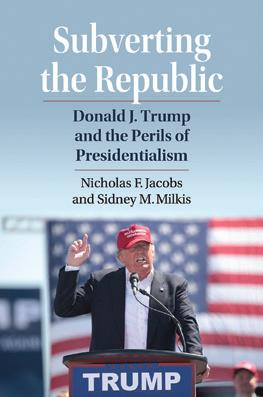
“Jacobs and Milkis have provided a thorough accounting of the Trump presidency that places it in historical and institutional context. They identify how ‘executive-centered partisanship,’ the result of institutional changes across the presidency and the party system, have created opportunities for Trump, while also delineating how these structures have influenced other presidents and the broader political system. This is a highly informative and theoretically robust book.”
Julia Azari, author of Delivering the People’s Message: The Changing Politics of the Presidential Mandate
“Jacobs and Milkis forcefully argue that Donald Trump wasn’t just an aberration but an extension of a revamped presidency that began decades before. A must-addition to the literature on the Trump presidency.”
John Kenneth White, author of Grand Old Unraveling: The Republican Party, Donald Trump, and the Rise of Authoritarianism

“Here is a fascinating look at the politics of the great American Midwest, which is too often ignored while other regions are covered more extensively. You will come away from this fine anthology with new perspectives on a wide variety of topics that explain the Midwest’s significant role in shaping our modern politics.”
Larry J. Sabato, coeditor of A Return to Normalcy? The 2020 Election That (Almost) Broke America
“Catherine McNicol Stock and Jon Lauck have brought together a collection of essays that adds nuance and depth to the historical discussion of Midwestern politics—where they have been, and where they are going. The region’s political tradition is far more layered and complicated than most people realize. Anyone who wants to understand Midwestern politics, or who thinks they already do, should read this engaging and eye-opening set of essays.”
Pamela Riney-Kehrberg, author of When a Dream Dies: Iowa, Agriculture, and the Farm Crisis of the 1980s
The Liberal Heartland A Political History of the Postwar American Midwest
Edited by Jon K. Lauck and Catherine McNicol Stock
Over the last two decades, the political narrative of the “liberal coasts” and the “conservative heartland” has become something of a truism, leading many Democrats to write off much of the Midwest as a Republican stronghold. Today’s polarized divide between rural and urban voters makes it easy to forget that things have not always been this way. The Liberal Heartland is a powerful reminder that the American Midwest has a progressive legacy that rivals the coasts.
Across twenty chapters, The Liberal Heartland traces the political history of this region from the post–New Deal period to the rise of the New Right and Donald Trump’s right-wing populism. The contributors explore the way liberals and progressives across the Midwest fought for expanding environmental protection, engaged in community activism, developed a queer-labor coalition before Stonewall, struggled for women’s rights and representation in the Plains states, opposed the death penalty, and mobilized for Indigenous self-determination, among other topics. In addition to well-known leaders like Harry Truman and George McGovern, the book highlights lesser-known figures, such as Lydia Cady Langer, Mary Jean Collins, Richard Hatcher, Jim Jontz, and Paul Wellstone.
A companion to the 2020 volume, The Conservative Heartland, The Liberal Heartland explores the history of the Midwest from a lessacknowledged perspective, recounting often forgotten stories that demonstrate the importance of the Midwest for New Deal liberalism and various forms of left-wing politics. This is a long-overdue book that represents a fresh look at the American heartland.
Jon K. Lauck is the founding president of the Midwestern History Association, editor in chief of the Middle West Review, and adjunct professor of political science at the University of South Dakota.
Catherine McNicol Stock is the Barbara Zaccheo Kohn ’72 Professor of History at Connecticut College.
MAY
400 pages, 10 photographs, 2 figures, 6 tables, 6 x 9
Hardcover ISBN 978-0-7006-3864-2, $49.99 (x)
Paperback ISBN 978-0-7006-3865-9, $32.99 (s) Ebook ISBN 978-0-7006-3866-6, $14.99
The Sick Chicken Case
The US Supreme Court and the New Deal
Williamjames Hull Hoffer
On May 25, 1935, in the midst of the Great Depression, the US Supreme Court handed down a series of decisions that dealt mortal blows to New Deal legislation and presidential initiatives—a day known to New Dealers as Black Monday. The most significant of these decisions was A.L.A. Schechter Poultry v. U.S., which members of the press promptly labeled the “sick chicken case.” In this decision, the Court declared the National Industrial Recovery Act unconstitutional, thus abolishing the National Recovery Administration and the hundreds of codes it had enacted. President Franklin D. Roosevelt denounced the Court’s action, which started him down the road to his ill-fated plan to pack the Court in 1937.
As Williamjames Hull Hoffer shows, however, the sick chicken case is about much more than a single piece of New Deal legislation. It is a window into American society during the Great Depression and the New Deal—a 1930s America before World War II and the Cold War, the age of radio and movie palaces, and a time of experimentation with government that some likened to fascism or communism, or maybe both. More than a landmark law case that threatened the New Deal, but ultimately did not, Schechter Poultry is not just about a sick chicken; it is about a sick nation trying to heal itself.
Williamjames Hull Hoffer is a professor of history at Seton Hall University, the author of Plessy v. Ferguson: Race and Inequality in Jim Crow America, and coauthor of The Supreme Court: An Essential History, both from Kansas.
Landmark Law Cases and American Society
FEBRUARY
228 pages, 5½ x 8½
Hardcover ISBN 978-0-7006-3815-4, $69.99 (x)
Paperback ISBN 978-0-7006-3816-1, $29.99 (x)
Ebook ISBN 978-0-7006-3817-8, $29.99

“Hoffer offers a skillful and insightful account of not only the Schechter litigation itself, but also of the political, economic, regulatory, and jurisprudential context from which it emerged, as well as its aftermath and legacy. His analysis is refreshingly impartial and levelheaded. Even those who may differ on some points of interpretation will profit from engagement with this lucid and informative study.”
Barry Cushman, author of Rethinking the New Deal Court: The Structure of a Constitutional Revolution
“Hoffer skillfully places the Schechter Poultry case in its historical and political context, and together with excellent legal analysis has produced a compelling and vibrant treatment of this landmark case. This excellent volume will be useful to anyone interested in the case, the nondelegation doctrine, the New Deal, the [in]famous Court packing plan, and the legal and historical development of federal power to regulate the national economy.”
Jack M. Beerman, author of The Journey to Separate but Equal: Madame Decuir’s Quest for Racial Justice in the Reconstruction Era
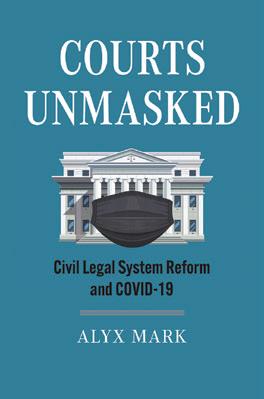
“Alyx Mark employs a rich body of evidence to describe and explain the responses of state court systems to the challenges created by the COVID pandemic. In doing so, she provides an innovative and valuable analysis of the realities of court administration in the United States.”
Lawrence A. Baum, author of The Supreme Court
“This exciting new research smartly capitalizes on the crisis brought about by the COVID pandemic to explore the fascinating complexities of administrative power within state court systems, including the capacity of lower courts in civil cases to modify day-to-day work practices. A truly outstanding achievement, Courts Unmasked is a must-read in numerous fields of scientific inquiry, including judicial politics, judicial reform, and public policy.”
Melinda Gann Hall, author of Attacking Judges: How Campaign Advertising Influences State Supreme Court Elections
Courts Unmasked Civil Legal System Reform and COVID-19
Alyx Mark
The COVID-19 pandemic changed the work practices of nearly every industry around the globe, forcing institutions to quickly adapt to the evolving public health emergency. The state court systems in the United States—from trial courts to state supreme courts—were no exception. In response to the crisis, courts were forced to make dramatic changes to the way they processed cases. The alterations ranged from selecting which types of cases should be prioritized or delayed to choices about which standards for filing documents and appearing at hearings could be relaxed. Petitions for emergency protective orders sped through the courts out of necessity, while small claims were processed far more slowly. Courts also allowed digital filings and video and phone call appearances without special permission. As Alyx Mark shows, COVID acted as an accelerant for procedural change and laid bare the different approaches to administrative decision-making that characterize the state courts. The distinctive and unifying case study created by the pandemic witnessed decisions that challenge prevailing explanations of how power manifests and process operates in state judiciaries.
The legal administrative changes brought significant differences to light in how state court systems design and implement policies that affect the administration of justice, revealing the degree to which such decisions are centralized. In states like Kentucky and Massachusetts, for example, high courts tended to craft orders that gave lower courts little room to make choices about their operations at the local level, reflective of these systems’ top-down approaches to court administration. In contrast, other supreme courts’ orders reflected the more diffuse nature of administrative power in their systems. Lower courts in Florida and Missouri interpreted their supreme courts’ orders to mean they were empowered to develop the administrative policies they deemed most appropriate. Given the discretion afforded to them, lower courts in Florida interpreted their high court’s wishes liberally, with their administrative orders offering judges the opportunity to make decisions about the appropriateness of remote hearings at the individual level.
Informed by an extensive data collection effort—encompassing administrative orders disseminated across state court hierarchies, as well as insights from nearly sixty interviews with elite court actors who participated in constructing and implementing these orders during the pandemic—Courts Unmasked uses the COVID-19 pandemic as the vehicle for exposing and unpacking the realities of power and process in state civil courts and what this might mean for the future of civil justice reform.
Alyx Mark is associate professor of government at Wesleyan University.
FEBRUARY
208 pages, 4 figures, 7 tables, 6 x 9 Hardcover ISBN 978-0-7006-3825-3, $69.99 (x) Paperback ISBN 978-0-7006-3826-0, $24.99 (x) Ebook ISBN 978-0-7006-3827-7, $24.99
MILITARY HISTORY | RUSSIAN AND SOVIET HISTORY
Red Storm over the Balkans
The Failed Soviet Invasion of Romania, Spring 1944
David M. Glantz
“With this publication, David M. Glantz has easily established himself as the doyen of military historians of the Eastern Front in World War II. The book breaks new ground in several important areas, one of the most significant being the number of historiographical issues that are confronted and resolved. . . . Glantz’s detailed and engrossing account is a lasting and overdue tribute to the men of both armies who fought in this long-forgotten campaign. It deserves a place on every military historian’s bookshelf.”—Slavic Review
“For those with a specialist interest in the Eastern Front, this authoritative book is required reading.”—Journal of Military History
“A must read for any serious student of the Eastern front.”—NYMAS Review
Modern War Studies
MARCH
462 pages, 44 photographs, 6 x 9
Paperback ISBN 978-0-7006-3948-9, $34.99 (x)
Ebook ISBN 978-0-7006-3956-4, $34.99
MILITARY HISTORY | CIVIL WAR
Davis and Lee at War
Steven E. Woodworth
Winner of the Fletcher Pratt Award
“This well-written and highly illuminating work is not only an incisive study of military command but a penetrating psychological analysis of Davis, Lee and other key figures of the Confederacy.”—New York Times Book Review
“Woodworth has made an outstanding contribution to Civil War literature.” The Historian
“There can be do doubting that this is an intelligent and fluently written book that dispenses much wisdom on matters of vexed controversy among Civil War historians.”—War in History
Modern War Studies
MARCH
424 pages, 18 photographs, 4 maps, 6 x 9
Paperback ISBN 978-0-7006-3954-0, $29.99 (x)
Ebook ISBN 978-0-7006-3909-0, $29.99
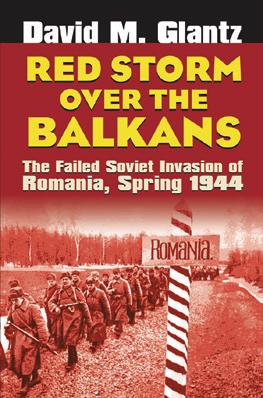
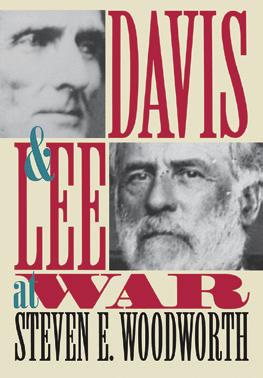
PRESIDENTIAL STUDIES | POLITICAL SCIENCE | US HISTORY
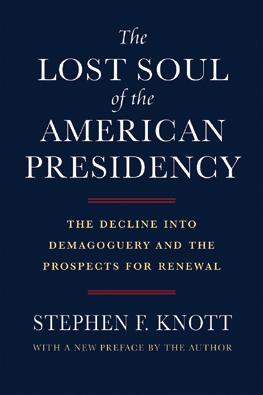
The Lost Soul of the American Presidency
The Decline into Demagoguery and the Prospects for Renewal
With a New Preface by the Author
Stephen F. Knott
“This book provides both rich historical details of early presidents and also a very timely discussion of the Donald Trump presidency.”—Congress & the Presidency
“This book is an enlightening tour de force that paints a picture of the evolution, and in [the author’s] view the degradation, of presidential leadership.”—Political Science Quarterly
“Meticulously researched and eloquently reasoned.”—Washington Times
FEBRUARY
318 pages, 20 photographs, 4 maps, 6 x 9
Paperback ISBN 978-0-7006-3039-4, $27.99 (s)
Ebook ISBN 978-0-7006-2851-3, $14.99
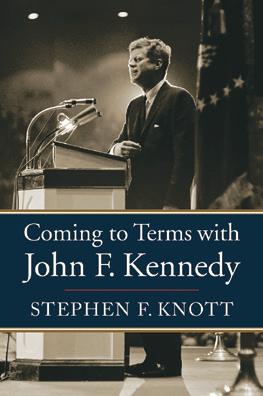
PRESIDENTIAL STUDIES | US HISTORY
Coming to Terms with John F. Kennedy
With a New Preface by the Author
Stephen F. Knott
“Stephen Knott provides a balanced account of key aspects of the Kennedy presidency that have been under contestation. One of Knott’s goals is to parley with hagiographers and ideologues of past and present to frame a counternarrative intended to deconstruct the many myths that have accrued over the years. . . . By offering an enlightened, reformative narrative, Knott has provided substantive material to help us think more clearly and judge more judiciously when evaluating John F. Kennedy. This is no mean accomplishment.”—Presidential Studies Quarterly
“Provides an excellent prism for conducting a more objective, balanced, and nuanced assessment of JFK’s presidency and some of his policies.” Congress & the Presidency
FEBRUARY
288 pages, 6 x 9
Paperback ISBN 978-0-7006-3952-6, $27.99 (S)
Ebook ISBN 978-0-7006-3366-1, $14.99
CONSTITUTIONAL STUDIES | LAW | US HISTORY
Punish Treason, Reward Loyalty
The Forgotten Goals of Constitutional Reform after the Civil War
Mark A. Graber
“In meticulous detail Mark Graber shows how in the run-up to the adoption of the Fourteenth Amendment congressional Republicans shaped the provisions eventually written into that provision with an eye to ensuring control of the government by Unionists, which is to say Republicans. He reorients our understanding of the Fourteenth Amendment away from the rights it undoubtedly guarantees to the political effects its framers sought to achieve, among which were Unionist control of state governments so that rights could be protected. Though today we do not pay much attention to the sections of the Fourteenth Amendment its framers cared most about, Graber’s arguments tell us a great deal about how we should understand what constitutions actually do.”
Mark Tushnet, William Nelson Cromwell Professor of Law, emeritus, Harvard Law School, and author of The Constitution of the United States of America: A Contextual Analysis
Constitutional Thinking
JANUARY
416 pages, 8 tables, 6 x 9
Paperback ISBN 978-0-7006-3949-6, $29.99 (s)
Ebook ISBN 978-0-7006-3504-7, $29.99
INTELLIGENCE STUDIES | US HISTORY
Treasonable Doubt
The Harry Dexter White Spy Case With a New Preface by the Author
R.
Bruce Craig
“Craig turns the complicated facts of White’s life into a terrific story, partly a spy yarn with philosophical overtones a la Graham Greene or Joseph Conrad, partly a convincing evocation of the mentality Craig calls ‘Rooseveltian internationalism.’ . . .The book is a work of prodigious and meticulous scholarship. On the basis of this achievement, Craig deserves to be ranked among the finest historians of the domestic Cold War.”
American Historical Review
“Exhaustively prepared, wholly fair and balanced in its analysis, and wholly right in its conclusions.”—Michael Straight, author of Trial by Television: The Army–McCarthy Hearings
APRIL
472 pages, 25 photographs, 6 x 9
Paperback ISBN 978-0-7006-3947-2, $29.99 (s)
Ebook ISBN 978-0-7006-3955-7, $14.99

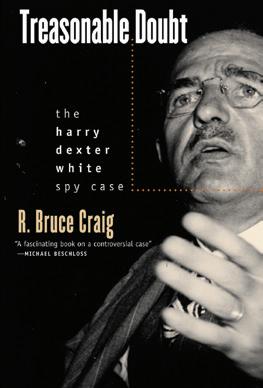
BIOGRAPHY | PRESIDENTIAL STUDIES | WOMEN’S STUDIES
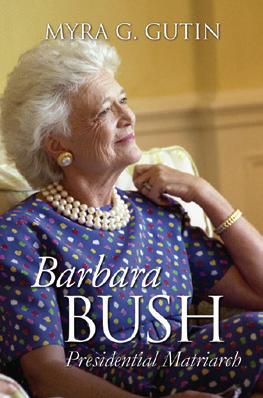
Barbara Bush
Presidential Matriarch
Myra G. Gutin
“A fascinating, impeccably researched, and long overdue biography by one of the nation’s leading experts on the American first lady. Gutin shows that this wife of one president and mother of a second was hardly just a grandmother in pearls, but a shrewd, thoughtful, and humorous political partner to two presidents named Bush. This is political biography at its best.”—John Robert Greene, author of The Presidency of George W. Bush
“A crisp and clean account of Barbara Bush’s emergence as one of the most compelling first ladies of our time. . . . Well-written and well worth reading.”—Gil Troy, author of Hillary Rodham Clinton
“Savvy and insightful.”—Herbert S. Parmet, author of George Bush: The Life of a Lone Star Yankee
Modern First Ladies
MARCH
240 pages, 15 photographs, 6 x 9
Paperback ISBN 978-0-7006-3950-2, $27.99 (s) Ebook ISBN 978-0-7006-2740-0, $14.99
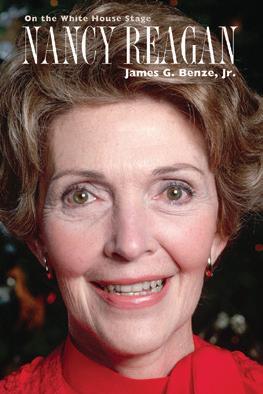
BIOGRAPHY | PRESIDENTIAL STUDIES | WOMEN’S STUDIES
Nancy Reagan
On the White House Stage
James G. Benze, Jr.
“Captures the drama and turmoil of the Reagans’ public life and tensions in their private lives, both tempered by Nancy Reagan’s fierce loyalty and deep love for her husband.”—Donald T. Critchlow, author of Phyllis Schlafly and Grassroots Conservatism: A Woman’s Crusade
“Anybody who wants to know more about this important and, at times, controversial First Lady should ‘just say yes’ to this engaging book.”
Chester J. Pach, author of The Presidency of Dwight D. Eisenhower
“Offers a useful perspective of the Reagan years from the vantage point of the East Wing of the White House.”—Choice
Modern First Ladies
MARCH
232 pages, 10 photographs, 6 x 9
Paperback ISBN 978-0-7006-3946-5, $27.99 (s) Ebook ISBN 978-0-7006-2370-9, $14.99
BIOGRAPHY | PRESIDENTIAL STUDIES | WOMEN’S STUDIES
Rosalynn Carter
Equal Partner in the White House
Scott Kaufman
“Kaufman uses interviews, press accounts, and some official papers to present a solid, balanced portrait of Rosalynn Carter, a first lady who left observers baffled about what role she was playing. . . . Kaufman reveals an active woman who worked hard for mental health, elder care issues, and the ERA.”—Journal of Southern History
“We can all benefit from Kaufman’s careful examination of Rosalynn Carter’s remarkable record. Not only did she compile an impressive list of ‘firsts,’ she openly acknowledged her clout, something her predecessors had hesitated to do. . . . Kaufman leaves no doubt about how she earned her place on the list of top ten.”—Journal of American History
Modern First Ladies
MARCH
220 pages, 19 photographs, 6 x 9
Paperback ISBN 978-0-7006-3951-9, $27.99 (s)
Ebook ISBN 978-0-7006-3957-1, $14.99
POLITICAL SCIENCE | US HISTORY
Citizenship and Democratic Doubt
The Legacy of Progressive
Thought
With a New Preface by the Author
Bob Pepperman Taylor
“In this thoughtful and provocative meditation on the shortcomings of the Progressive temperament, the political theorist Bob Pepperman Taylor gives a close reading of texts by six writers from the era, Walter Lippmann, Herbert Croly, John Dewey, Jane Addams, Carl Becker, and Aldo Leopold. . . . This work is a welcome addition to the dialogue of current historians about the development of social justice both as ideology and practice and the role of gender in those developments.”
Journal of American History
“Because Taylor considers Progressive Era thinkers as ‘the most creative, optimistic, and committed generation of democratic thinkers and activists in American history,’ he has undertaken a philosophical analysis of selected progressive thinkers as a guide to good citizenship and democratic practice. . . . A well-written book.”—Historian
American Political Thought
MAY
208 pages, 6 x 9
Paperback ISBN 978-0-7006-3953-3, $27.99 (x)
Ebook ISBN 978-0-7006-3958-8, Open Access edition for free download
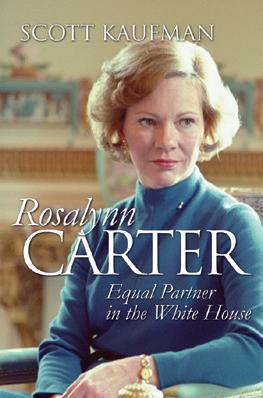
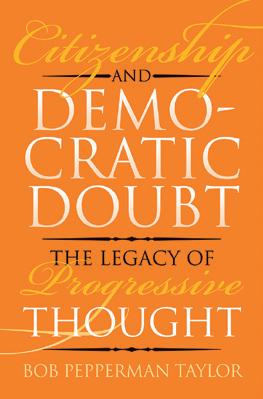
KANSAS | LGBTQ+ STUDIES
No Place Like Home
Lessons in Activism from LGBT Kansas
With a New Preface by the Author
C.J. Janovy
Finalist for the Lambda Literary Award for LGBTQ Nonfiction
Winner of the Stubbendieck Great Plains Distinguished Book Prize
Named a Kansas Notable Book by the Kansas Center for the Book
“This exquisitely written book captures the experiences and emotions of everyday activists and shows how politics informs personal lives. This work reveals how losses regarding pro-LGBT policies and protections ‘in the long game, often built to victories.’ A riveting, insightful love letter to Kansas’s unsung LGBT heroes. Highly recommended.”—Choice
JUNE
308 pages, 14 photographs, 6 x 9
Paperback ISBN 978-0-7006-2834-6, $29.99 (t)
Ebook ISBN 978-0-7006-2529-1, $14.99

In addition to print editions, you can now order ebooks directly from us. See our website for more details: https://kansaspress.ku.edu/ebooks/
Please give us code 24SCS25 when ordering by web or by other means.
University Press of Kansas
2502 Westbrooke Circle • Lawrence KS 66045-4444
Telephone 785-864-4154 • Orders 800-848-6224
Fax 800-272-6817 • E-mail upress@ku.edu • Orders orders@longleafservices.org Visit www.kansaspress.ku.edu Follow us on Facebook: www.facebook.com/kansaspress Instagram: www.instagram.com/kansas_press
University Press of Kansas
2502 Westbrooke Circle
Lawrence KS 66045-4444
Phone: 785-864-4154 Fax: 785-864-4586
Email: upress@ku.edu www.kansaspress.ku.edu
Orders: 800-848-6224
Email orders: orders@longleafservices.org
General Information
Prices of forthcoming books are tentative and are subject to change without notice. Unless otherwise noted in the description, all bindings are in cloth. A (t) following a price indicates trade discount to booksellers. Trade discount is extended to retailers on all prepaid orders. A complete list of titles in print is available on our website. Any claims for shipping discrepancies, shortages, or damages must be made within thirty (30) days of invoice date.
Individuals can order through our secure shopping cart: www.kansaspress.ku.edu.
Direct orders from individuals must be prepaid in US funds or charged through VISA, Mastercard, Discover, or American Express and must include postage and handling (see order form).
Returns Policy
Returns from booksellers and wholesalers will be accepted without written permission from the Press. Full credit will be given only if 1) the invoice number are date of order are supplied, 2) the books being returned are in print, and 3) the books returned are in fully salable condition.
Please send University Press of Kansas returns as of their respective dates along with your usual Longleaf Services’ returns to: Longleaf Services, Inc.
c/o IPS Distribution Solutions Returns 1550 Heil Quaker Blvd Ste 200 LaVergne, TN 37086
Examination Copies
Examination copies for text consideration are available to faculty members. Make requests on departmental letterhead by mail or fax, with name of course, approximate enrollment, and the semester/year taught. Include $6 to cover processing and shipping (payable to the University Press of Kansas by check or credit card). Limit of three paperback titles per semester. For hardback copies, contact the Marketing Department.
Foreign Rights Inquiries
For all UPK foreign and translation rights queries, please contact
Jennifer Schaper
International Rights Manager Duke University Press & Longleaf Services jennifer.schaper@duke.edu
Sales Representatives
MID-ATLANTIC AND NEW ENGLAND
New York, New Jersey, Pennsylvania, Maryland, Delaware, Washington, DC, West Virginia, Connecticut, Maine, Massachusetts, New Hampshire, Rhode Island, Vermont:
Parson Weems Publisher Services
Christopher R. Kerr 11 Penhallow St. Boston, MA 02124-2307
Phone/Fax: 914-329-4961
ChrisKerr@parsonweems.com
Eileen Bertelli
48 Wawayanda Road
Warwick, NY 10990
Phone: 845-987-7233
Fax: 866-861-0337
eileenbertelli@parsonweems.com
Causten Stehle
310 N. Front Street, Ste. 4–10 Wilmington, NC 28401
Phone: 914-948-4259 Fax: 866-861-0337 office@parsonweems.com
Jason Kincade 19 Bushwick Avenue, 3R Brooklyn, NY 11211
Phone: 347-244-2165 jasonkincade@parsonweems.com
MIDWEST
Illinois, Indiana, Iowa, Kentucky, Michigan, Missouri, Minnesota, Nebraska, North Dakota, South Dakota, Ohio, Wisconsin:
Zach Zeigler
University Press of Kansas 2502 Westbrooke Circle
Lawrence KS 66045
Phone: 785-864-1385 zzeigler@ku.edu
WEST
Oregon, Washington, Idaho, Montana, Colorado, New Mexico, Utah, Wyoming: Jim Sena Wilcher Associates 2838 Shadowglen Drive
Colorado Springs, CO 80918
Phone: 719-210-5222
Fax: 719-434-9941 sena.wilcher@gmail.com
California, Arizona, Nevada: Tom McCorkell 26652 Merienda #7 Laguna Hills, CA 92656
Phone: 949-362-0597 Fax: 949-643-2330 tmccork@sbcglobal.net
Kansas, metropolitan Kansas City, and international territories not listed below:
Zach Zeigler University Press of Kansas 2502 Westbrooke Circle Lawrence KS 66045 Phone: 785-864-1385 zzeigler@ku.edu
INTERNATIONAL
UK, Europe, Central Asia, Middle East, & Africa:
Mare Nostrum Group 39 East Parade Harrogate North Yorkshire HG1 5LQ United Kingdom
Trade Orders & Enquiries
Email: trade@wiley.com Tel: +44 (0)1243 843291
Individual Orders & Enquiries: Orders should be placed through your local bookstore, an online retailer, or via email: info@eurospan.co.uk.
Japan: MHM Limited 1-1-13 Kanda Jimbocho Chiyoda-ku Tokyo 101-0051 sales@mhmlimited.co.jp www.mhmlimited.co.jp
University Press of Kansas
2502 Westbrooke Circle
Lawrence, Kansas 66045-4444
The University Press of Kansas publishes books that expand the impact of sound scholarship and amplify the voices of America’s Heartland.
Founded in 1946, we represent the six state universities: Emporia State University, Fort Hays State University, Kansas State University, Pittsburg State University, the University of Kansas, and Wichita State University.
The press is a member of the Association of University Presses.



